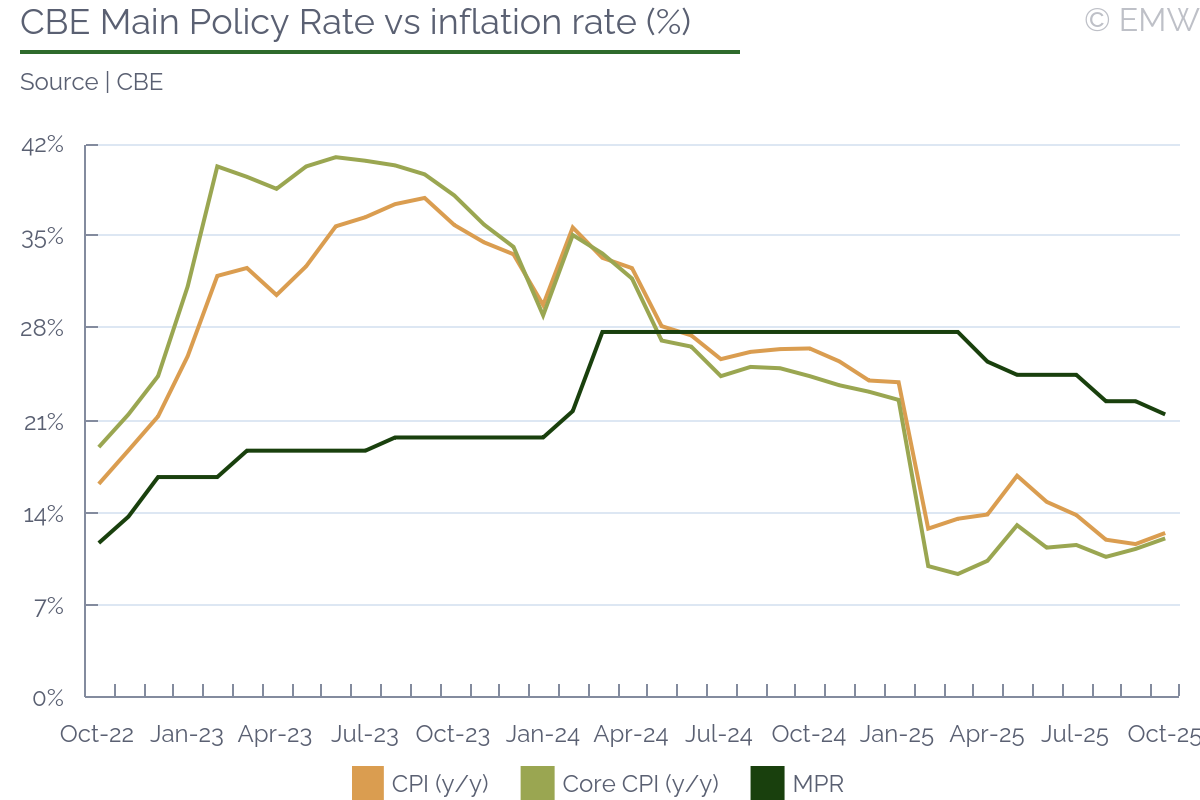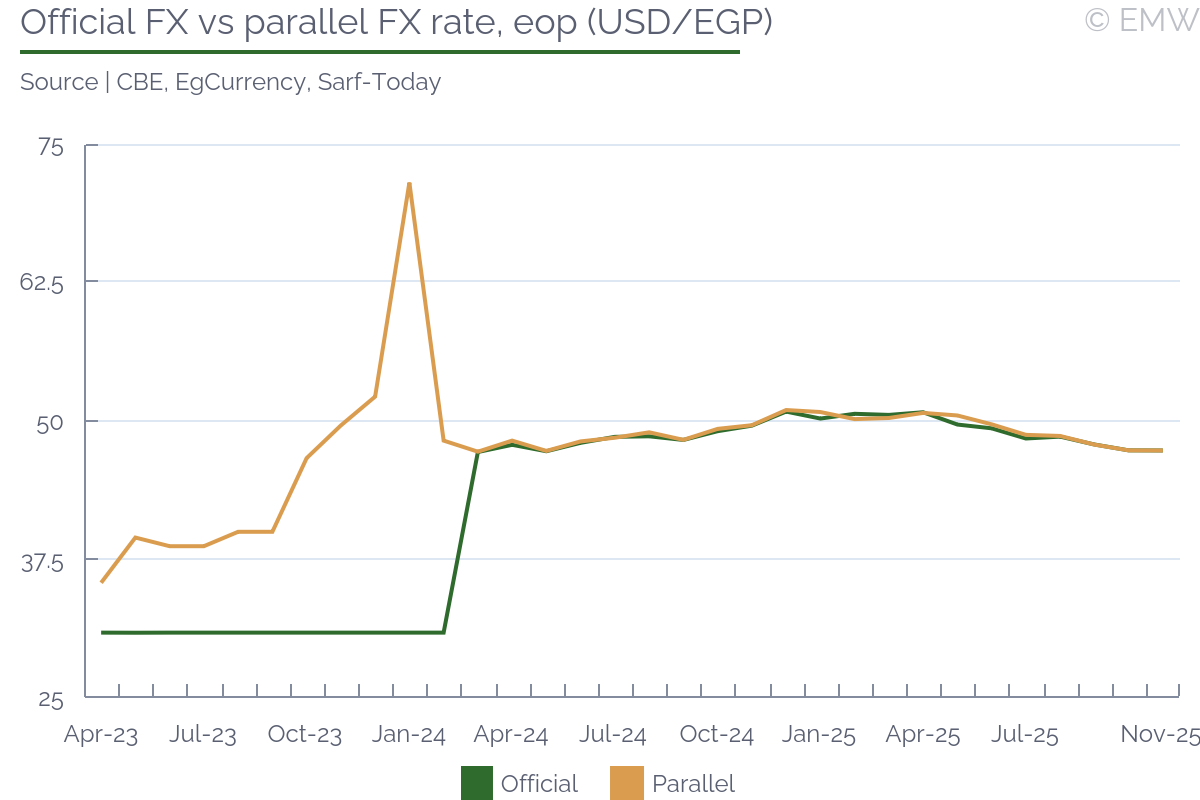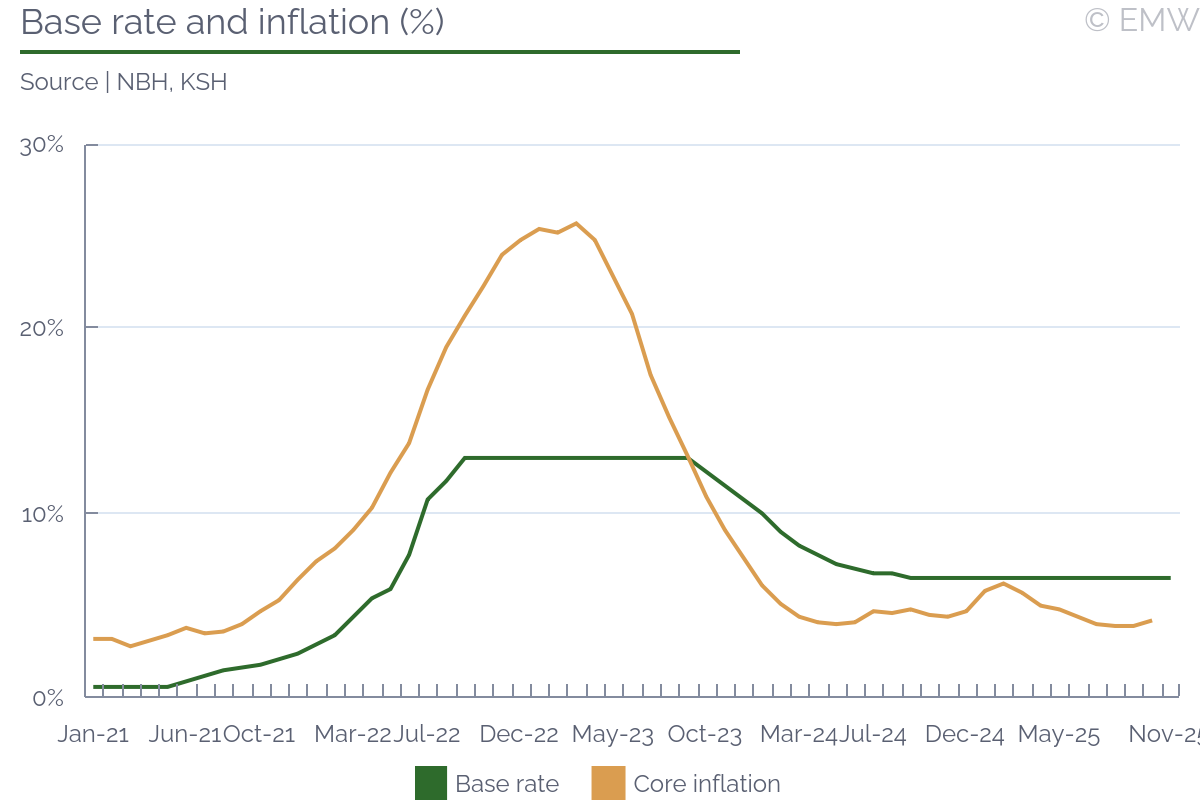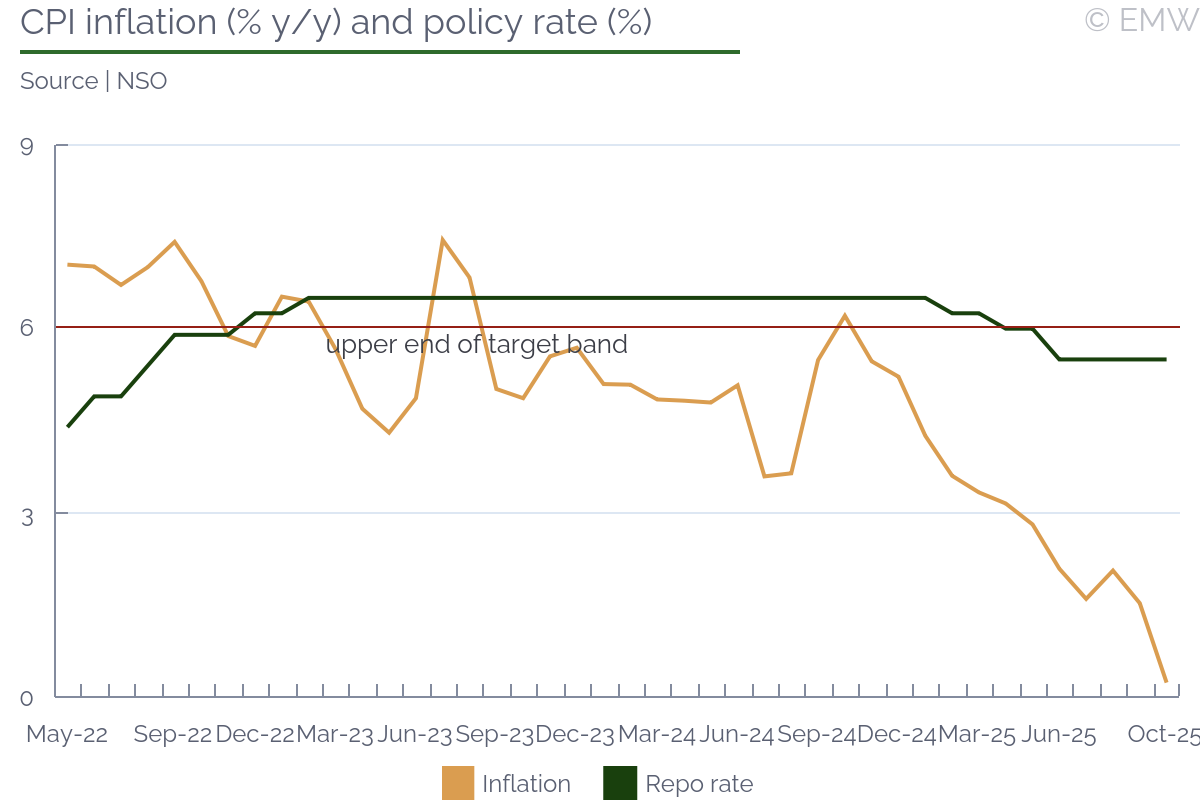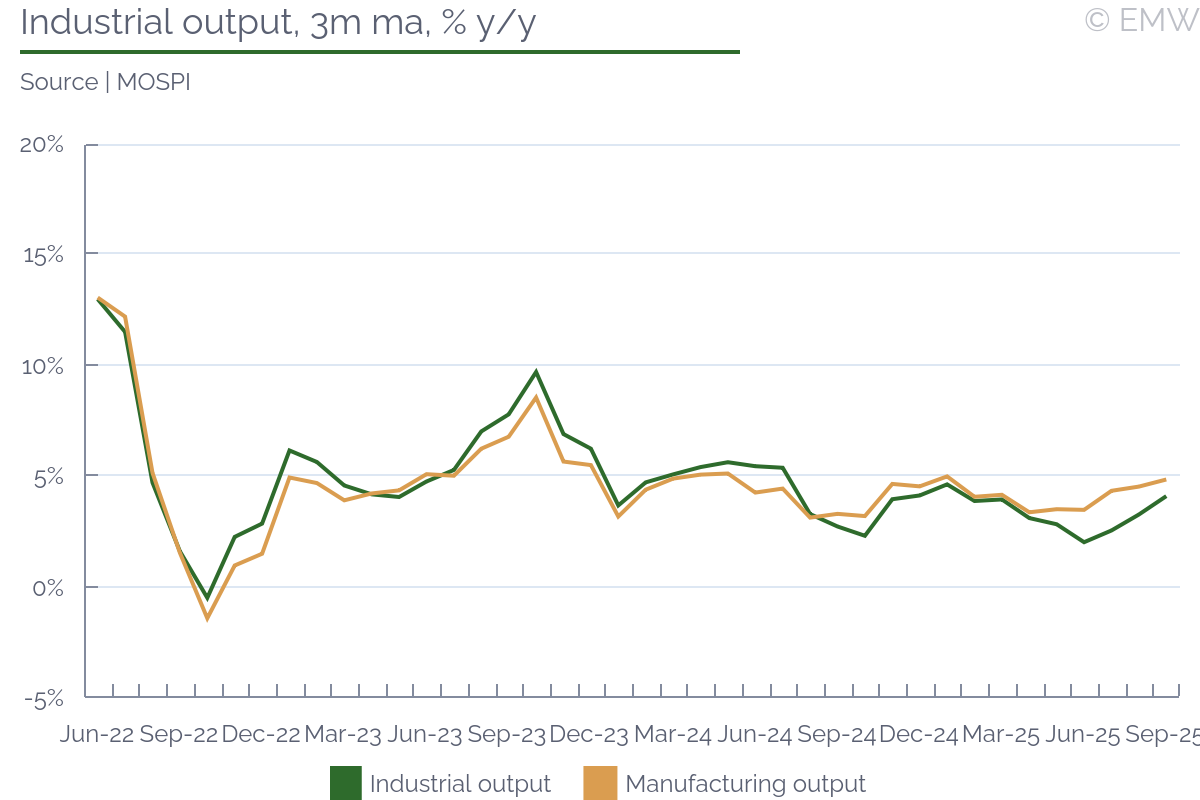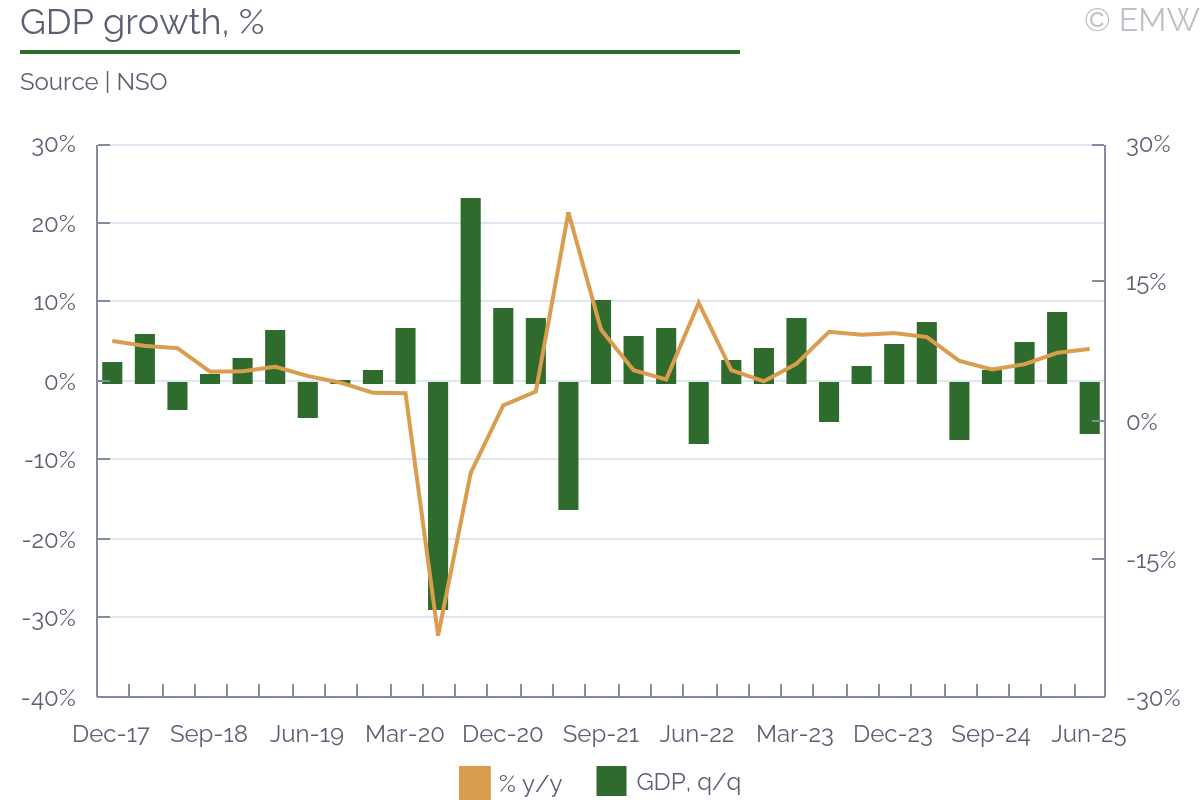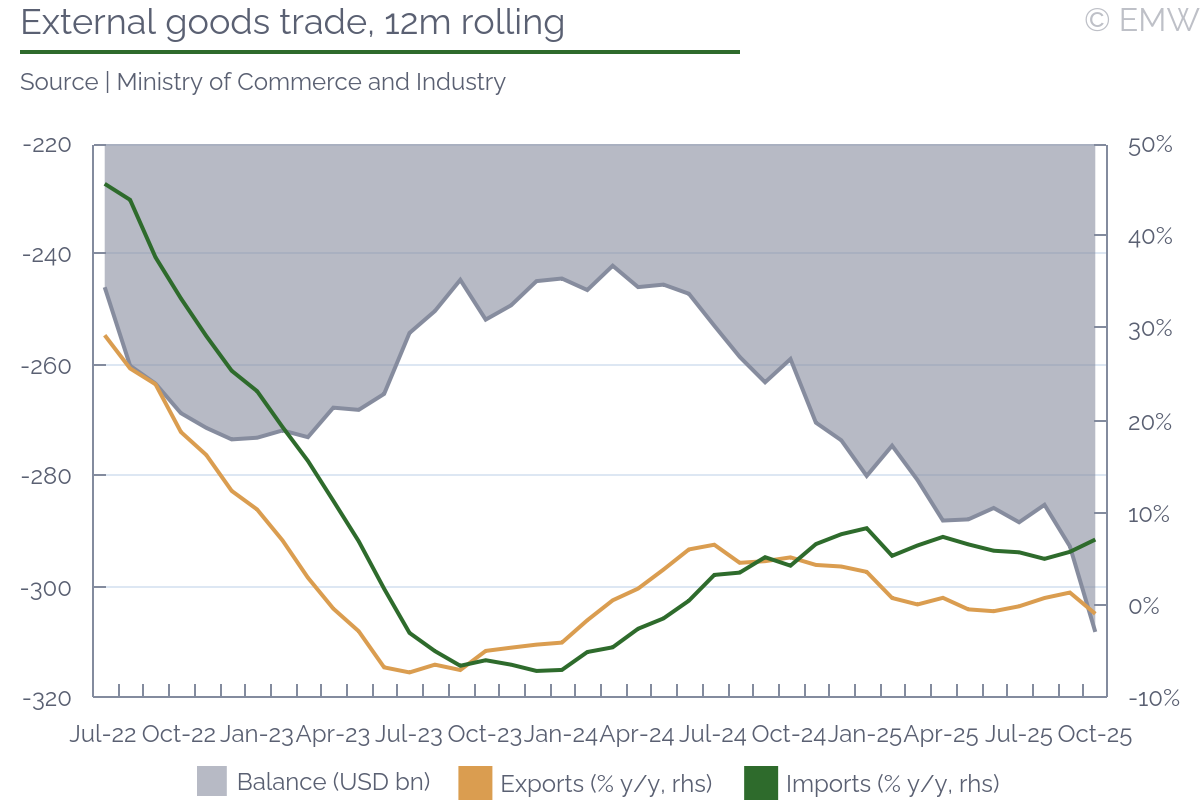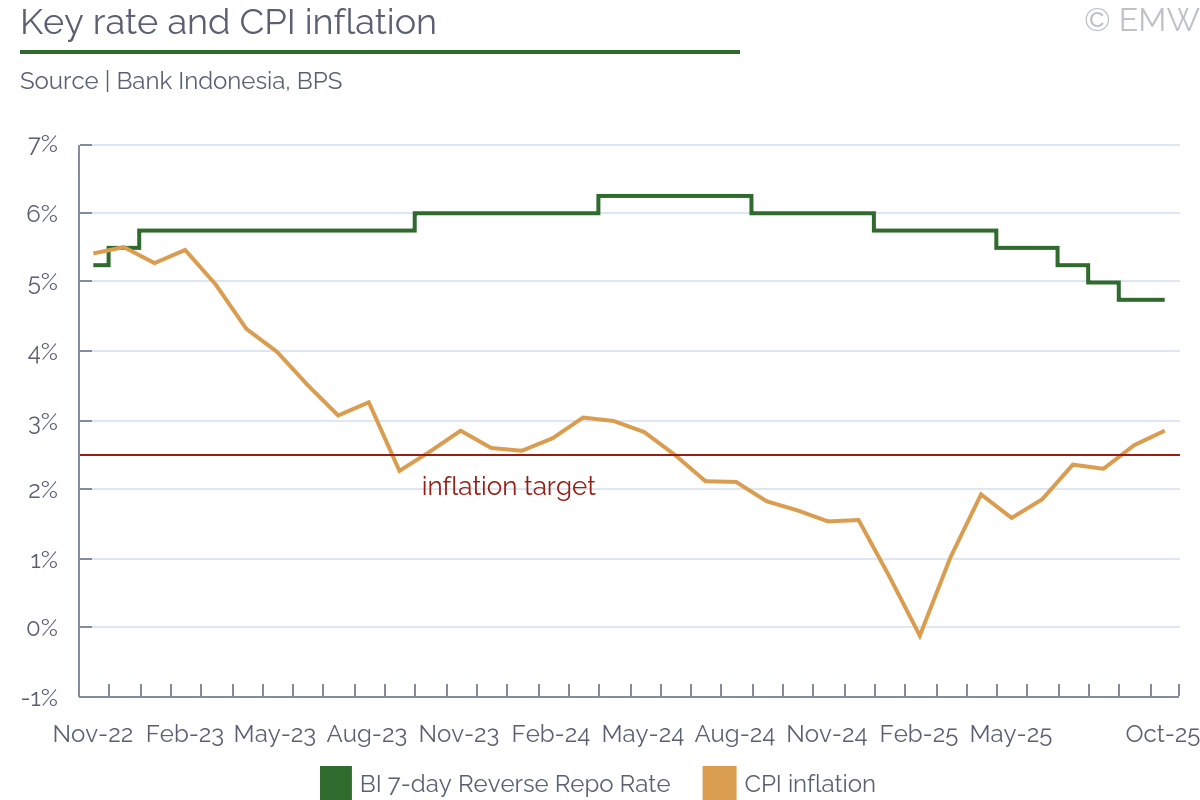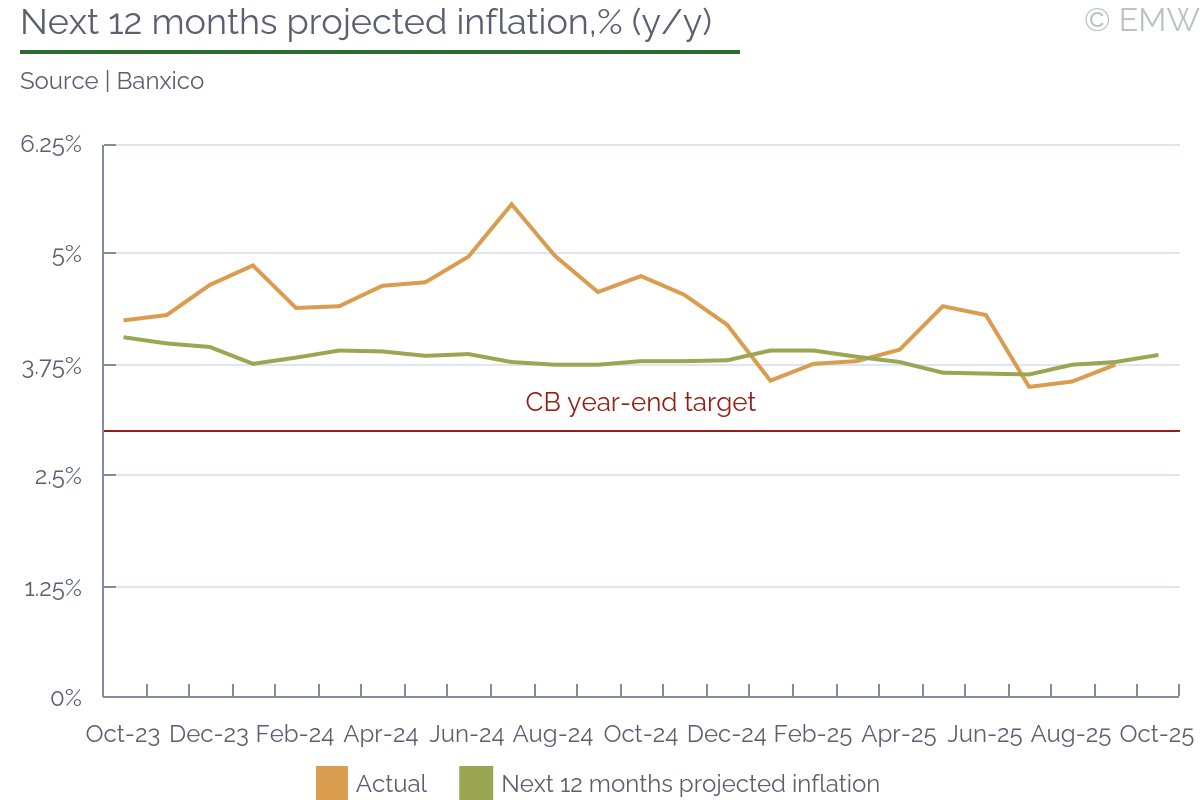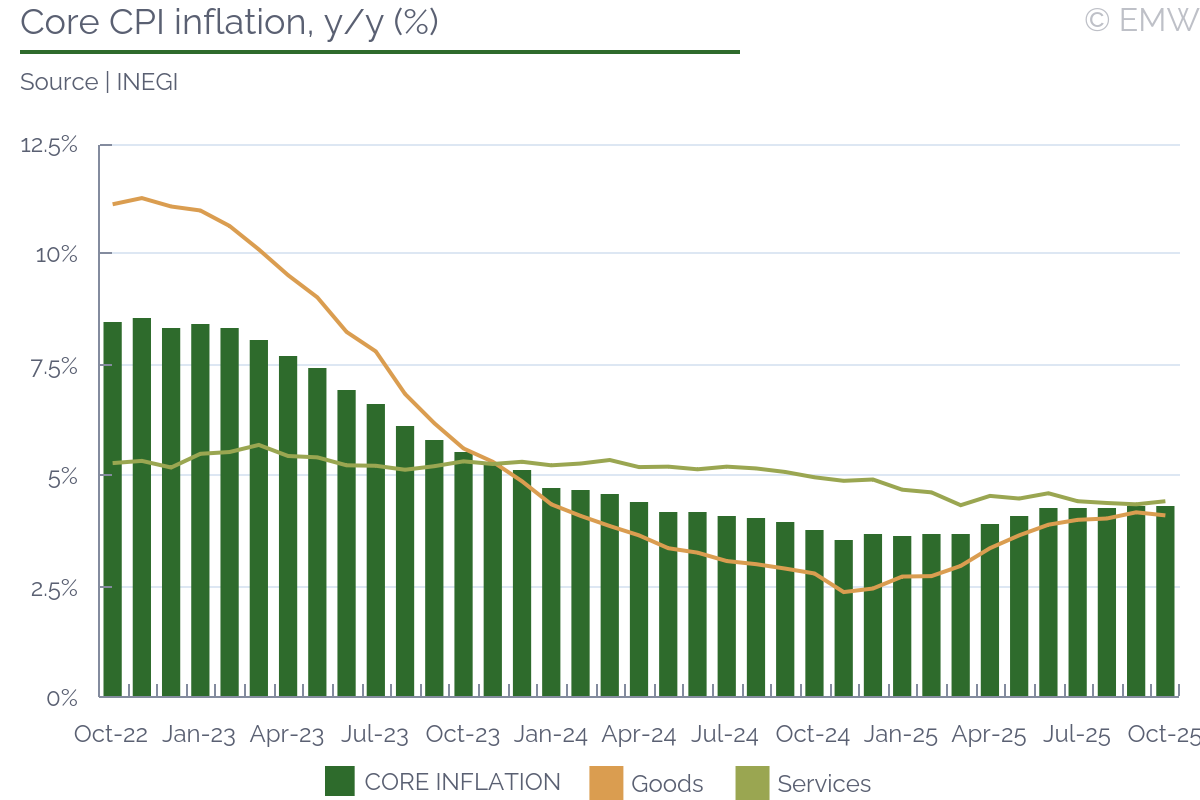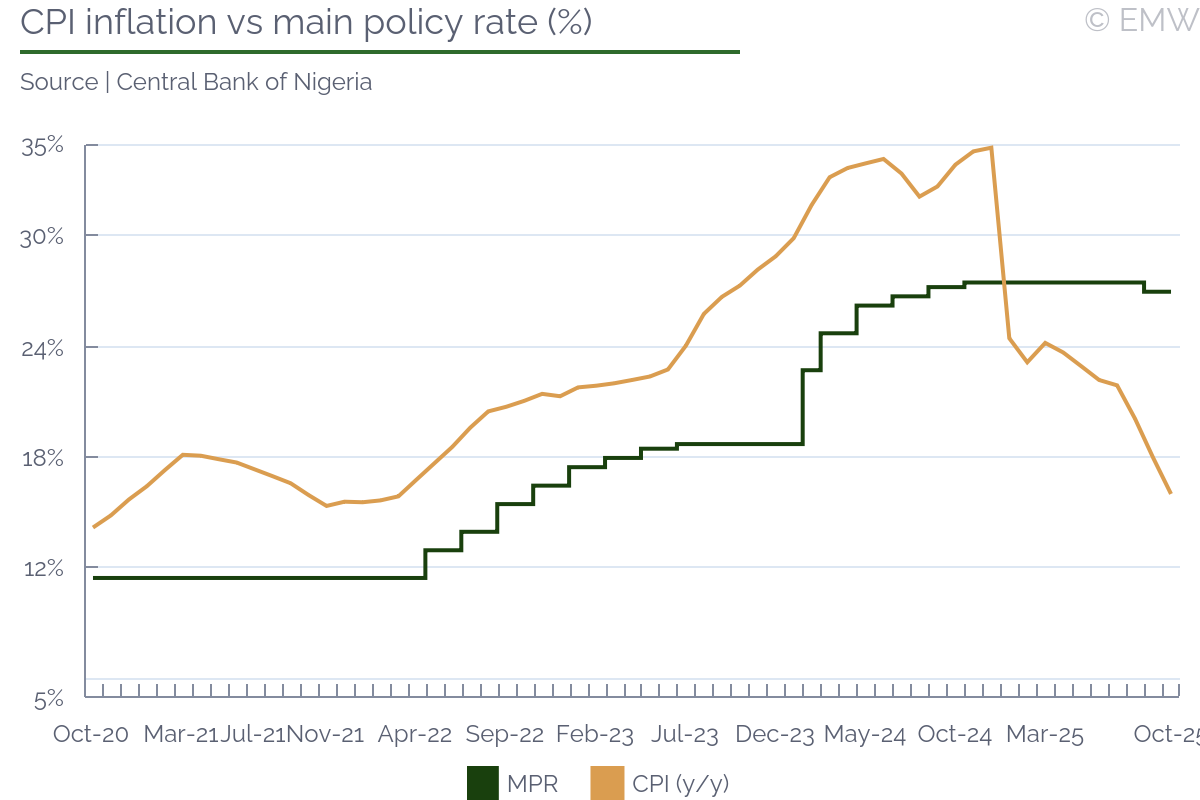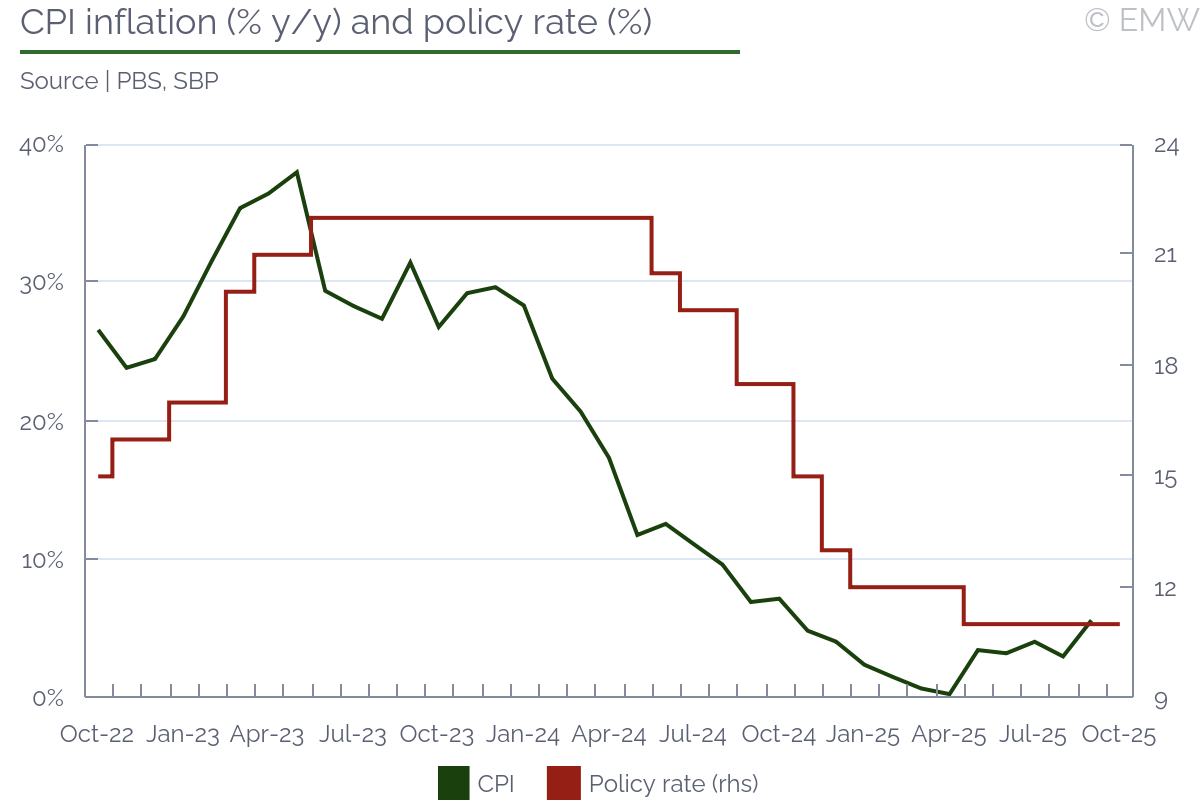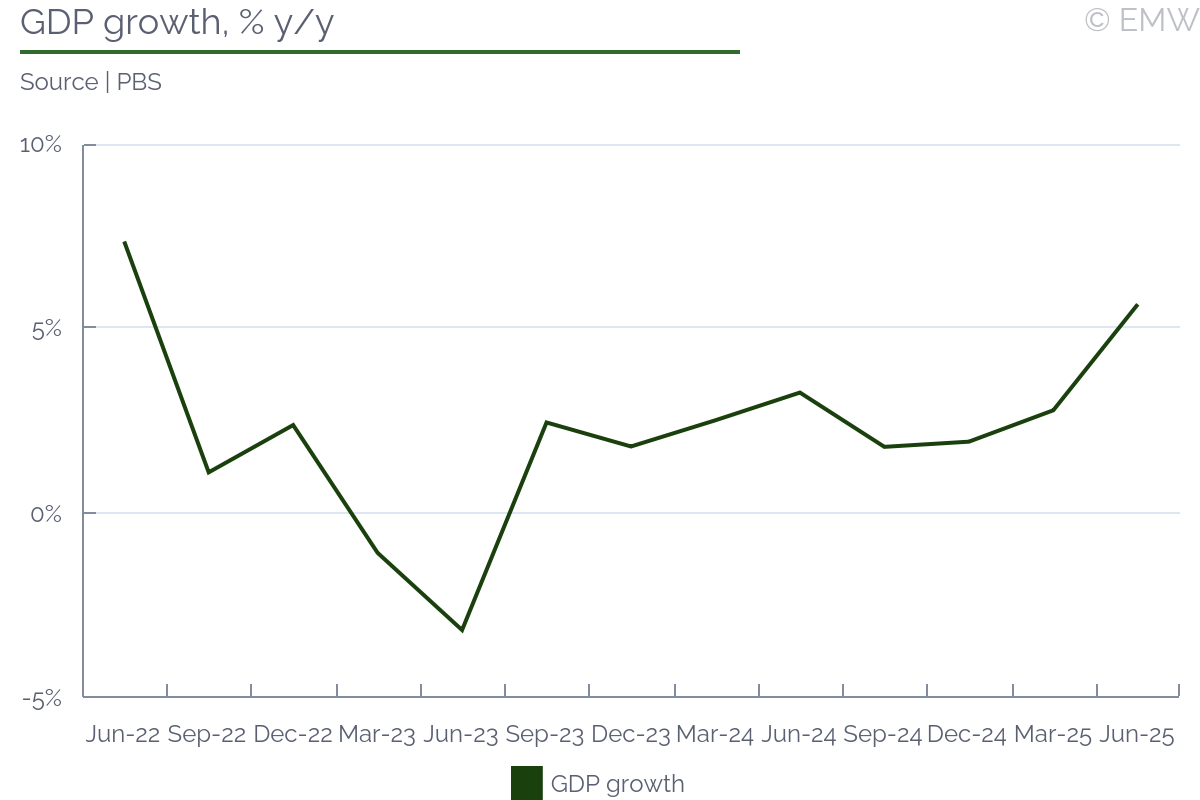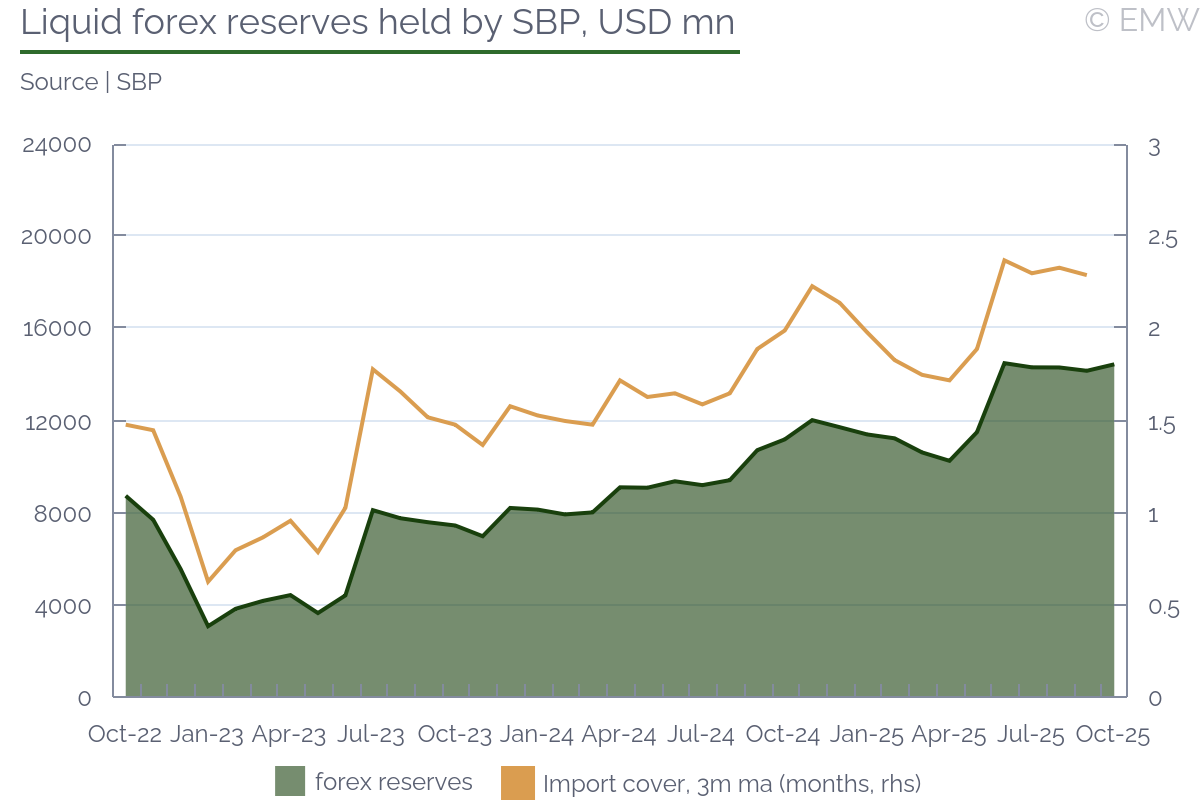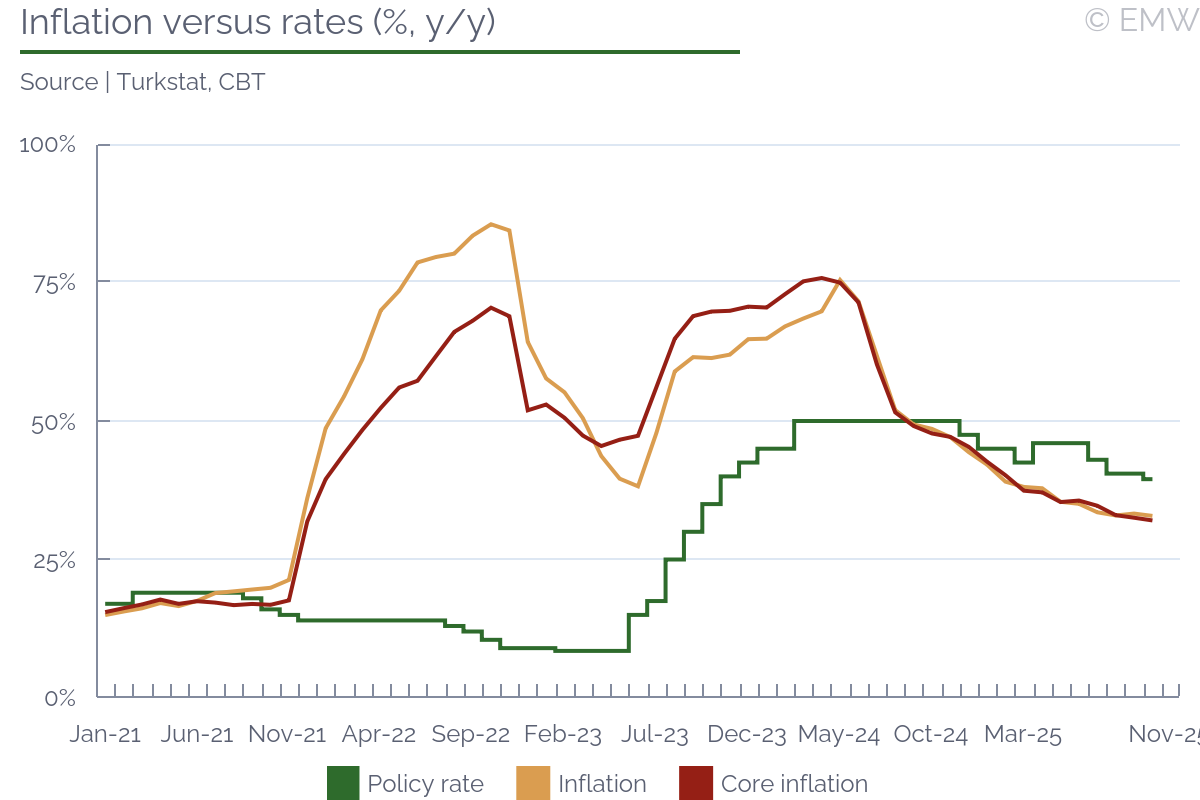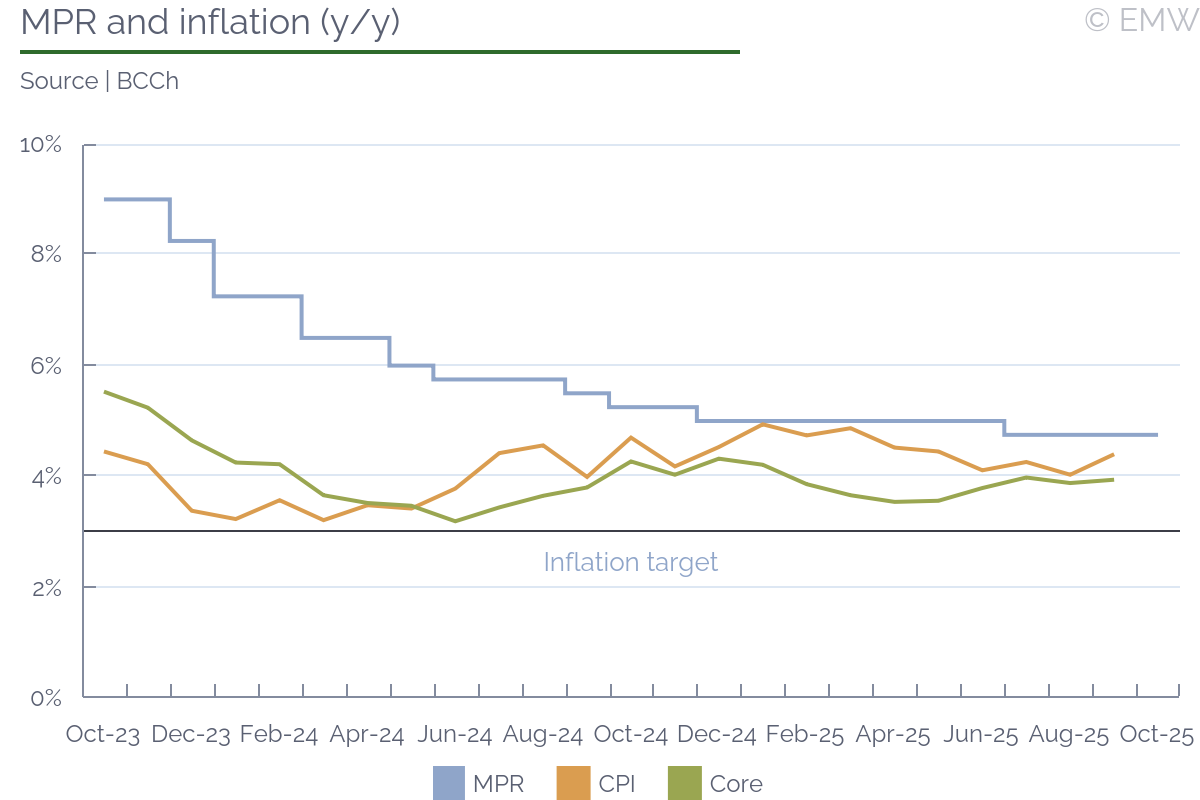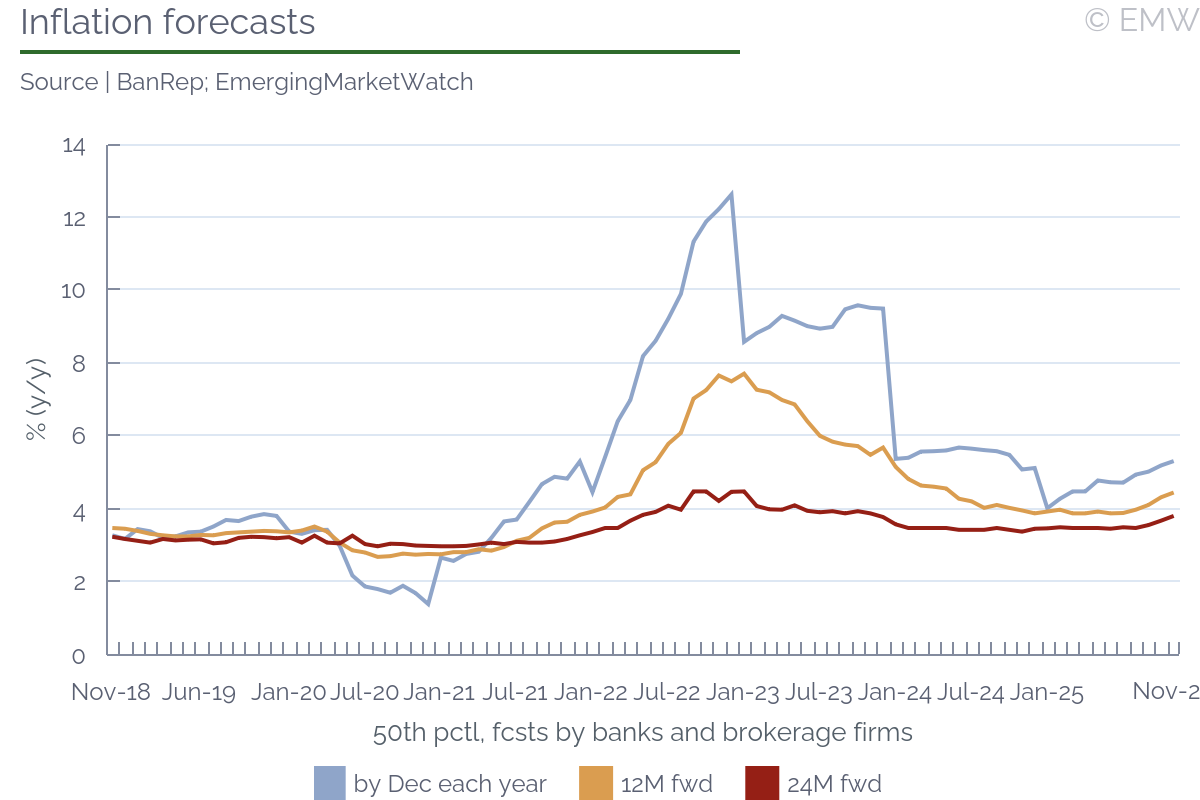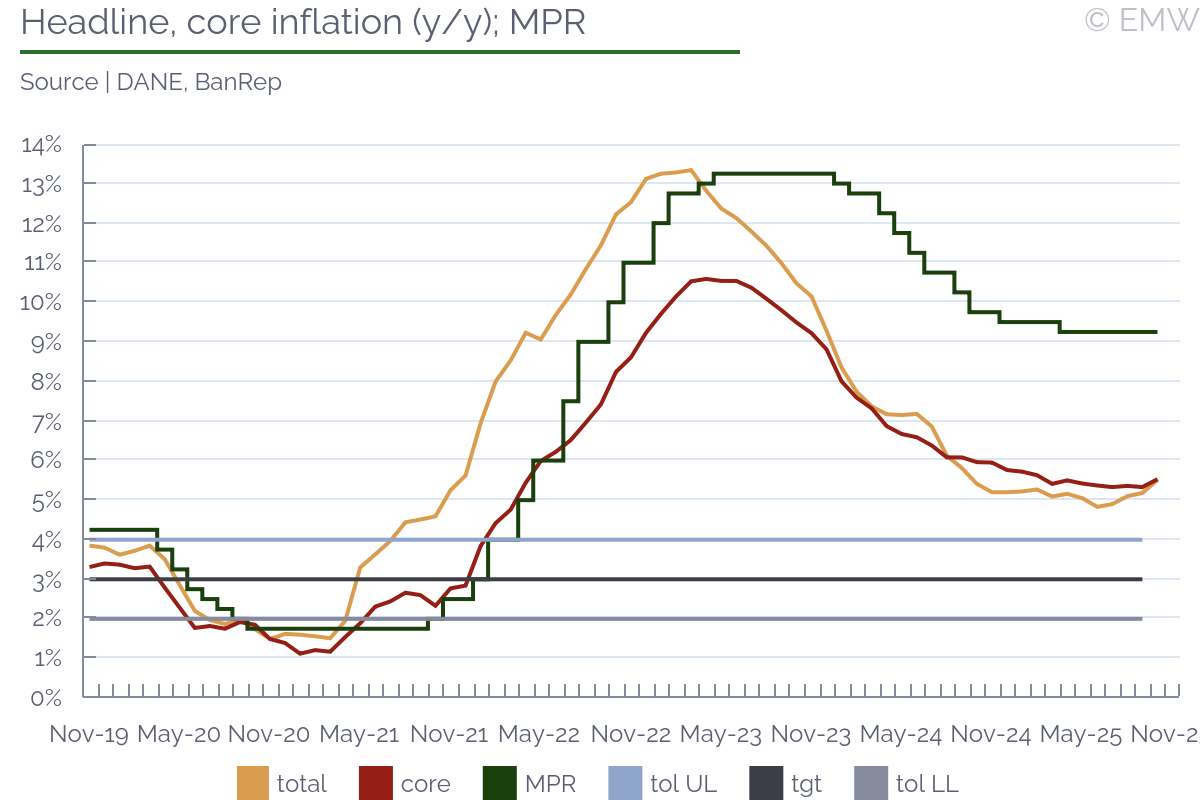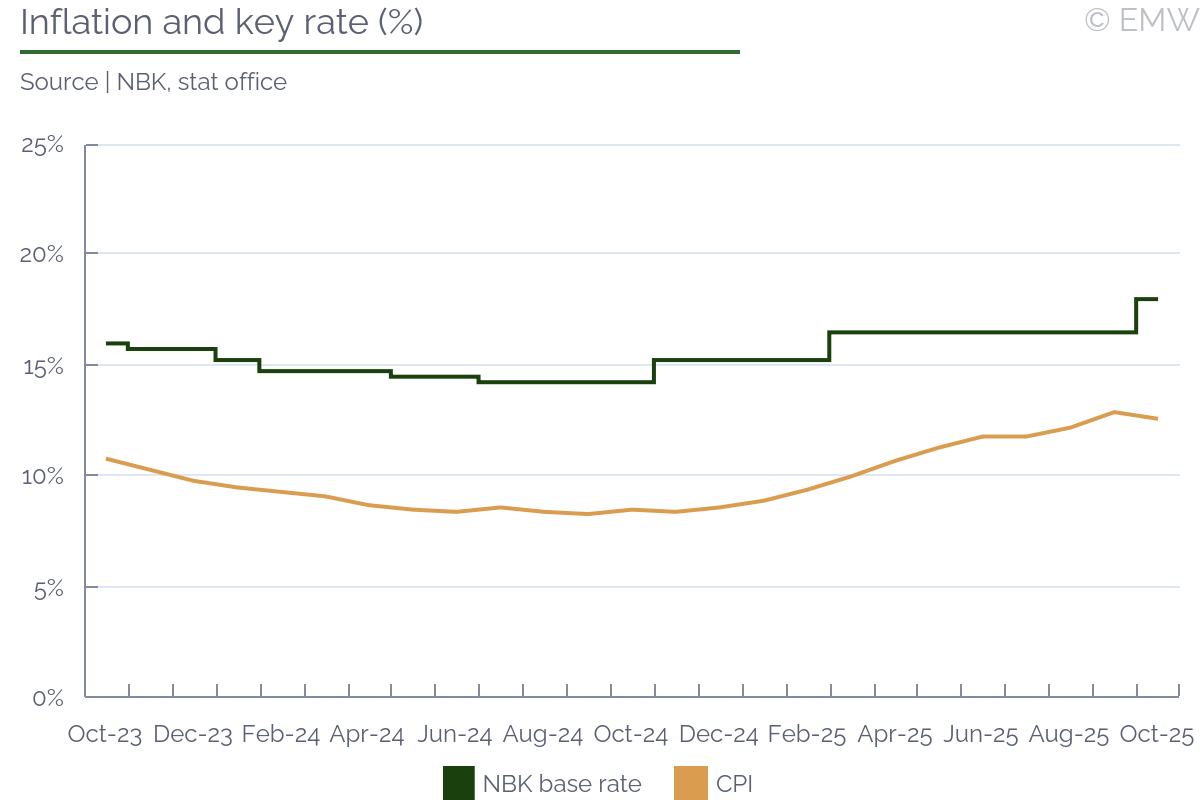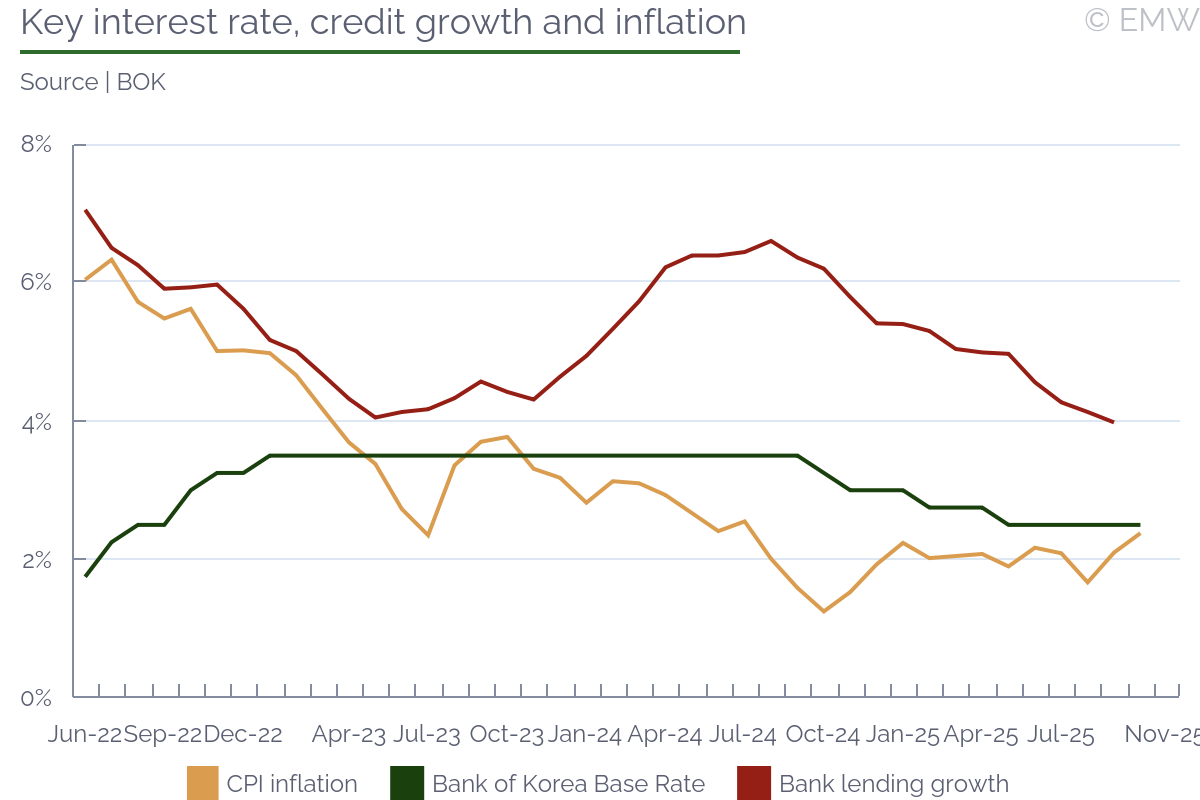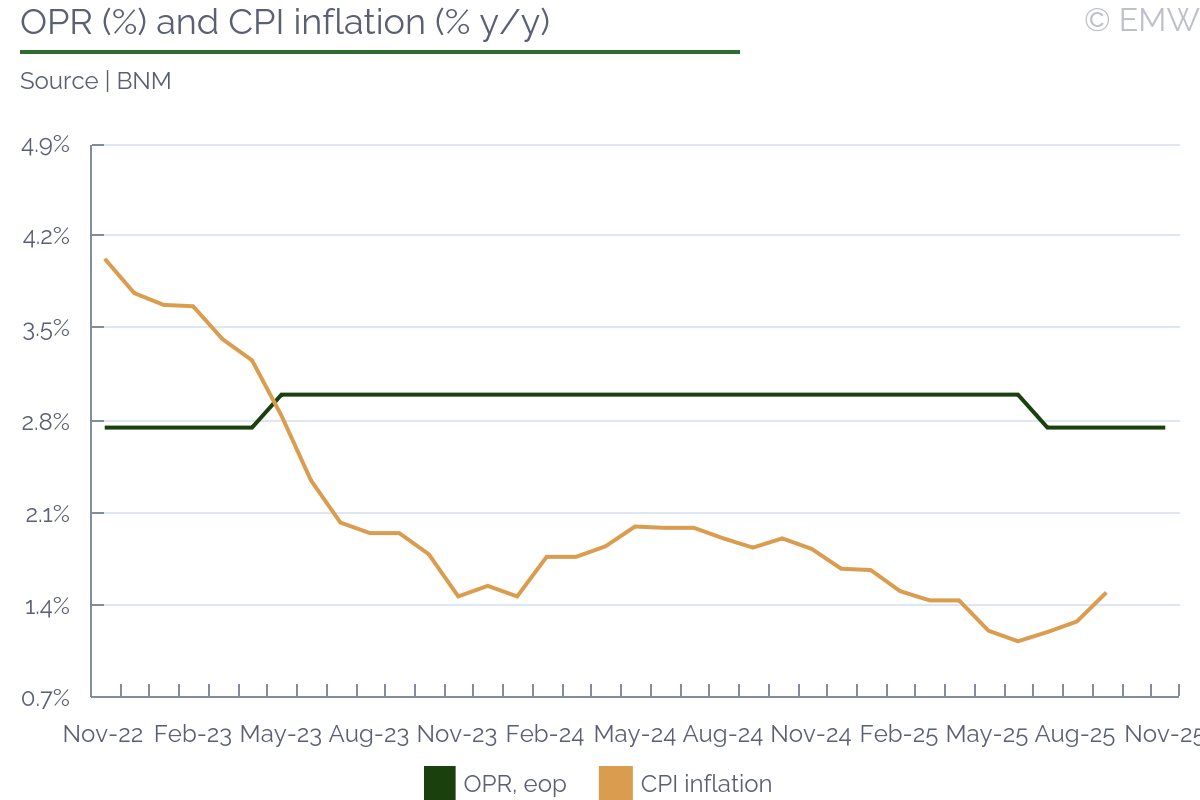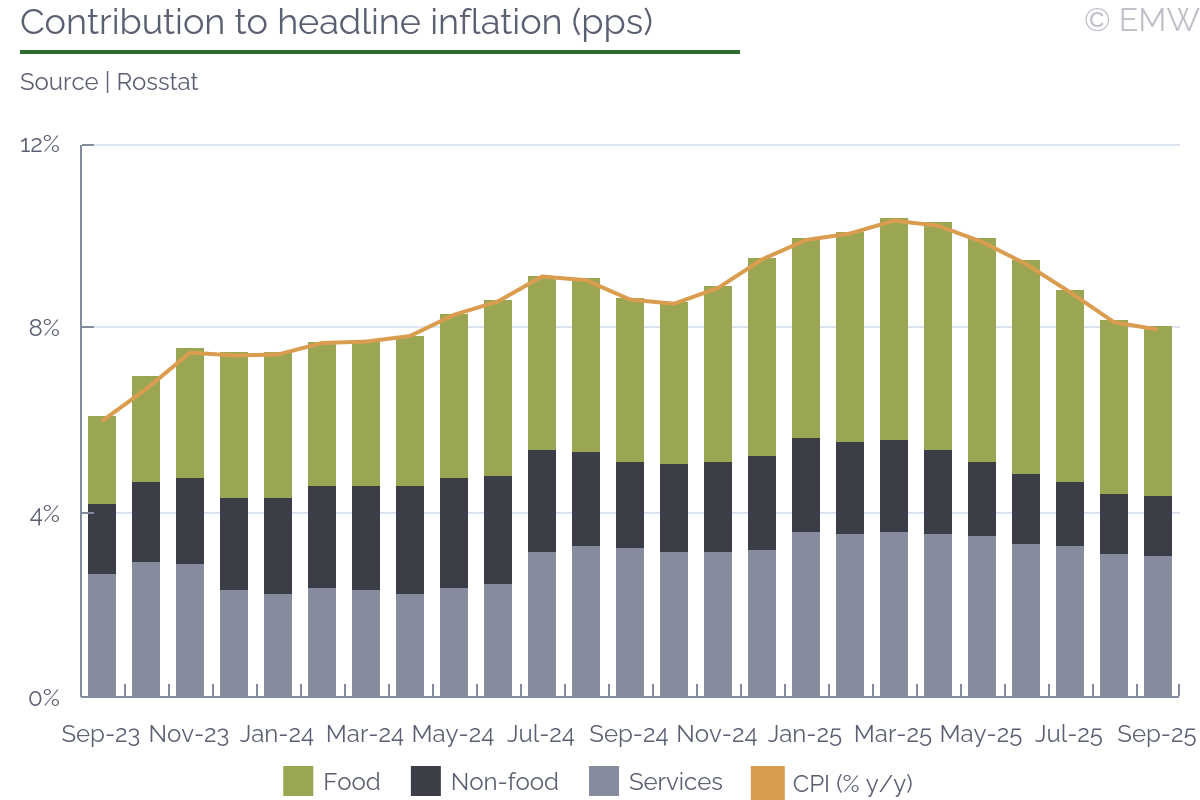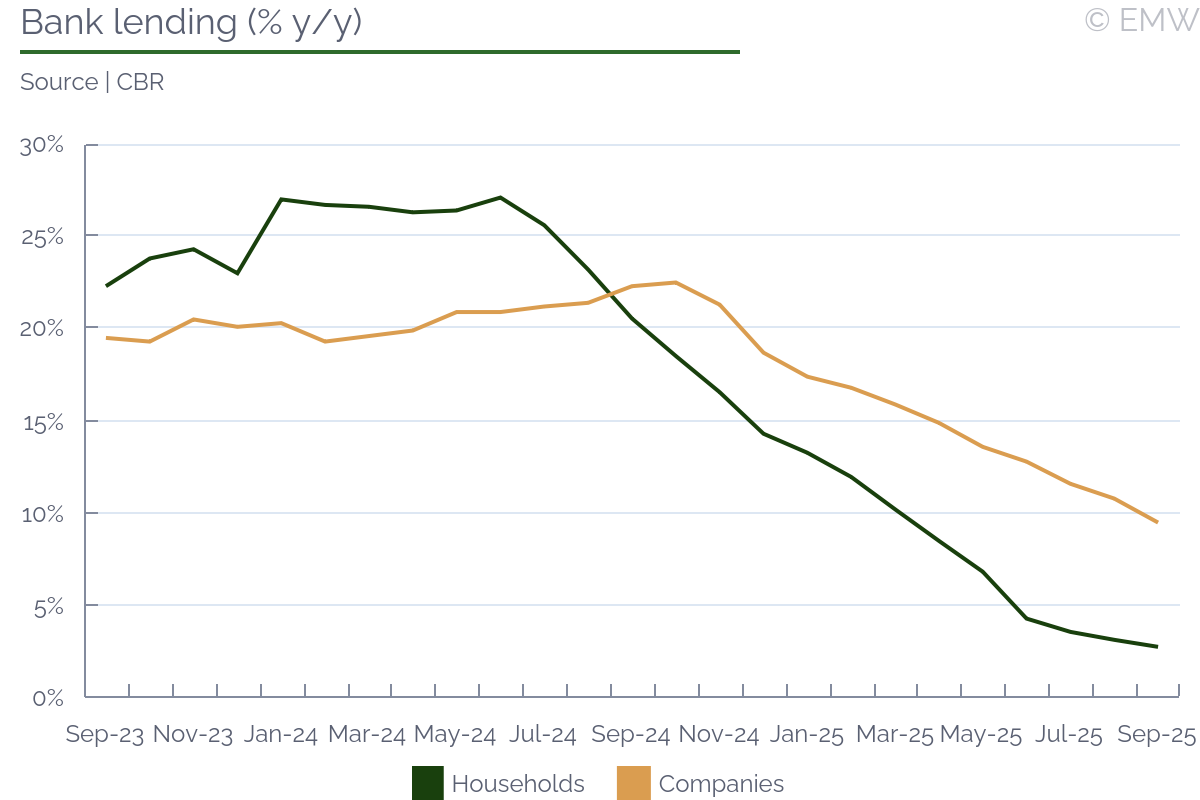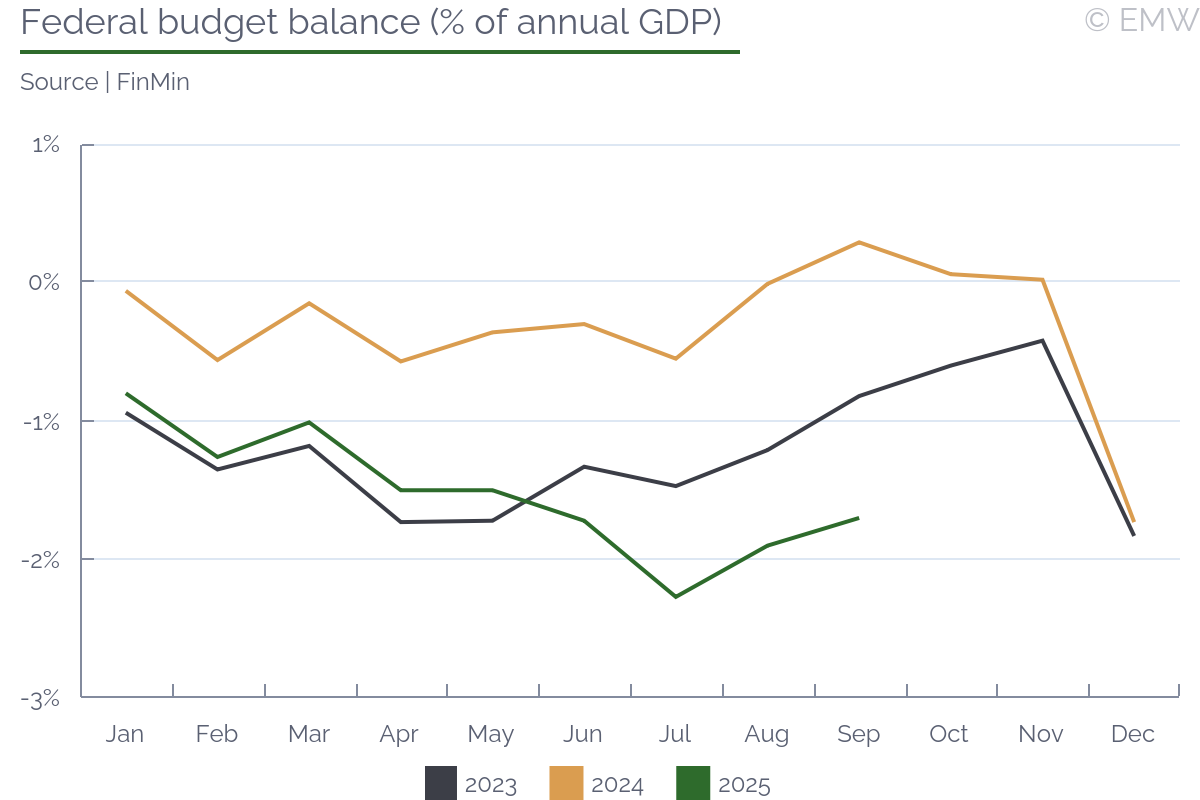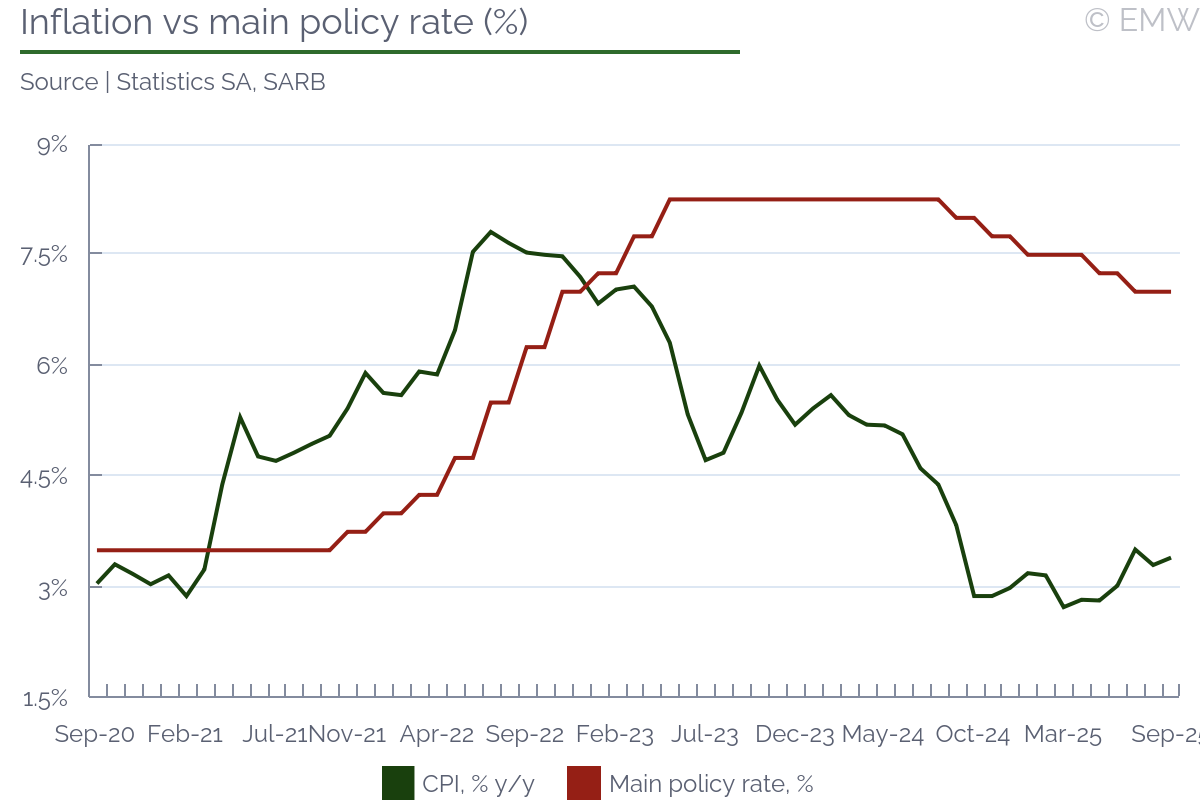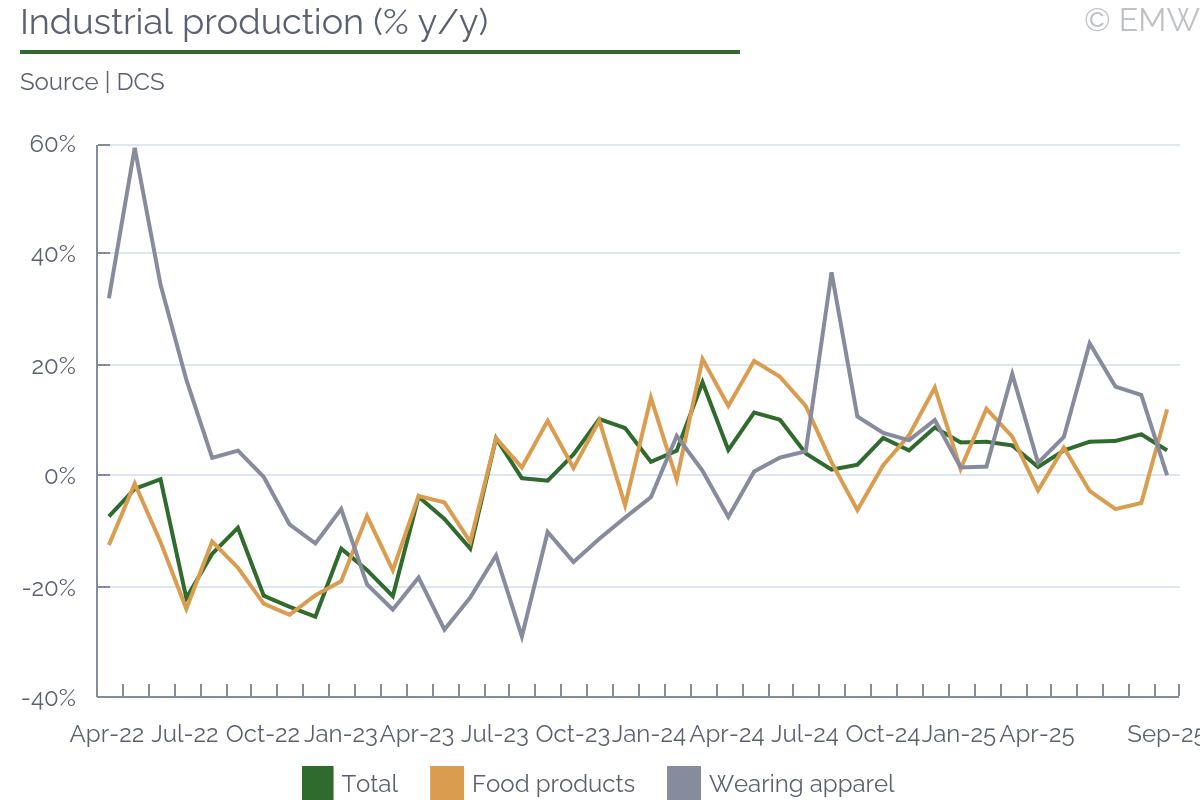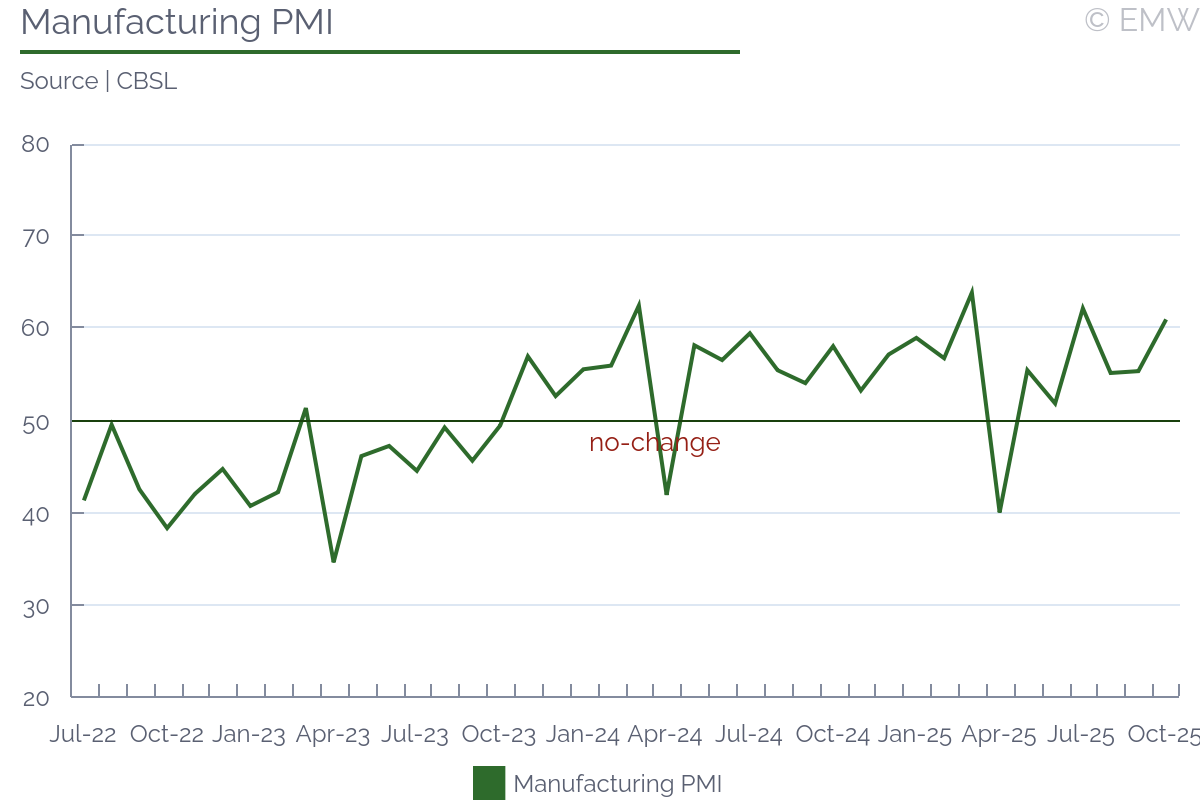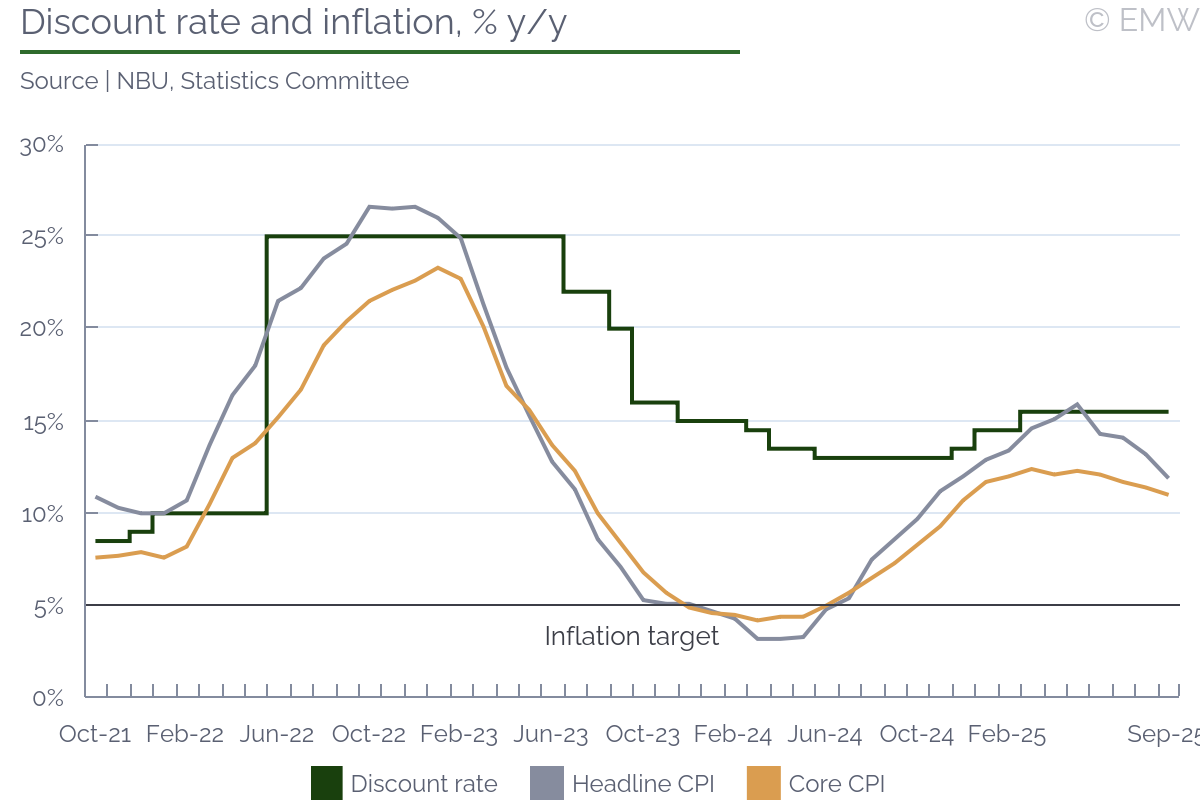
We have launched our new DATA page. You can access it here or by clicking on the DATA button on our website
| BCRA to keep policy rate and crawling peg moving closely in line with m/m CPI |
| Copom members indicate Selic will be held in Dec, easing start still uncertain |
| Interest rate stability to continue well into 2026 |
| MPC may cut rates by 100bps on Thursday ignoring impact of fuel price hike |
| MPC remains watchful over forint stability, inflation expectations |
| Easing inflation leaves room for December cut |
| Bank Indonesia to keep key rate on hold in December |
| Poor inflation performance, lingering pressure are not to derail December easing |
| MPC to cut rates in November amid continued disinflation |
| SBP likely to keep key rate unchanged through June 2026 |
| BSP likely to cut policy rate in December |
| MPC set for 25-bp cut in December, though it'll be close call |
| CBT to cut rates by 100-200bps, disinflation trend demands pause instead |
| BCCh's cautious guidance hints next cut waits for 2026, decision tree simplified |
| Inflation expectations rise again in Nov, lifting odds of a BanRep Dec hike |
| MPC will likely pause monetary easing in early January |
| NBK still expected to keep base rate on hold |
| BOK likely to hold due to hotter inflation, unhinged housing price expectations |
| BNM to stand pat in near term on improved growth outlook, modest inflation |
| NBR very likely to hold policy rate at 6.5% at least by end-Q1 2026 |
| CBR likely to keep key rate at 17%; moderate cut remains an option |
| MPC set to signal confidence in disinflation path and opt for cut in November |
| CBSL to hold rates in near term |
| Hold decision, 25bp rate cut both possible on Dec 17 |
| Another on-hold decision by central bank is likely on Oct 23 |
| BCRA to keep policy rate and crawling peg moving closely in line with m/m CPI |
- BCRA to raise quickly next time CPI inflation comes at 7.0% m/m or close
- BCRA needs to keep monthly effective rate and crawling peg closely in step with inflation to reduce export delay and portfolio dollarization incentives
- Unsustainable deficit+debt dynamics keep BCRA from pursuing positive real rates or depreciation
- BCRA can only passively respond to rising inflation, this status quo likely remains until regime change
The BCRA's future monetary policy rate decisions will remain bounded by the evolution of effective inflation, expected inflation for the short-term, and the interest rate limitations the central bank faces if it is to keep the official real exchange rate steady in the coming year, which is something the bank is paying close attention to. The BCRA hiked its benchmark 28-day bill rate by 300bps to 78.0% in mid-March to accommodate the monthly effective rate at 6.5%, up from 6.3%, in what was the first move for the rate since last September. The decision was taken following the release of a surprisingly high 6.6% m/m CPI inflation print for February and with market expectations of a similar reading for March. The BCRA is likely to raise another 200bps or 300bps if the CPI reading for March is close 7.0% m/m, unless high-frequency price trackers show a deceleration in early April.
Monetary policy has been passive for most of the past three years, sitting under the weight of massive fiscal dominance and past policy mistakes, and there are no prospects for this to change until the end of this government in December. To put it in short, the BCRA needs to keep its monthly effective benchmark rate and the official exchange rate crawling peg moving right in step with CPI inflation, and it doesn't have room to deviate much or for too long, which means monetary policy should be fairly predictable this year. The BCRA has slightly more room to delay rate cuts if inflation declines than it has room to delay rate hikes if inflation rises, but it seems very unlikely that inflation will decline this year anyway.
The dangerous inflation spiral and the massive real exchange rate appreciation that took place in 2021-22 put pressure on the BCRA to raise nominal interest rates and push the pace on the crawling peg when inflation rises. If the crawling peg lags versus inflation, the government would be increasing the incentives for exporters to withhold sales abroad and wait for an inevitable devaluation, while also reducing competitiveness (most exporters are forced to convert their FX income into local currency). This would add to an FX market crisis that has the government burning through its low FX reserves. However, if the nominal crawling peg is to move faster, interest rates also need to rise in step to avoid creating incentives to delay exports. Interest rates that at least match inflation are also key to discourage portfolio dollarization through parallel exchange rates, which are an increasingly important benchmark for price-setting practices.
The BCRA also needs to be careful of not going too high with real rates because it would contribute to the explosiveness of public debt dynamics and inflation. With the government running a fiscal deficit of more than 4.0% of GDP every year despite having virtually no access to market financing, the deficit has been covered by a mix of inflation tax and central bank balance sheet deterioration. The higher the real interest rate goes, the faster the deterioration of the central bank's balance sheet and the growth of the federal government's short-term debt. However, the evolution of market financing for the government and the BCRA's remunerated liabilities suggests that the room to get financing through these avenues is pretty much closed now, which only leaves inflation tax as an option. In this scenario, nominal interest rate hikes are inflationary as long as there are no drivers to increase the private sector's willingness to finance the government.
| Ask the editor | Back to contents |
| Copom members indicate Selic will be held in Dec, easing start still uncertain |
- MPC meeting: Dec 9-10, 2025
- Current policy rate: 15.00%
- EmergingMarketWatch forecast: Hold
The tone adopted by Copom members in recent public remarks suggests the committee is likely to keep the Selic rate unchanged at 15.00% at its final policy meeting of the year on Dec 9-10. BCB Governor Gabriel Galípolo said recently the current restrictive policy stance is working and helping reduce market uncertainty about the central bank's commitment to its mandate. He stressed that the Copom remains concerned about the level of inflation, which has been persistently above the target and which continues to justify a tight policy stance. Galípolo did also note that tail risks have diminished, with that being an indication that the beginning of an easing cycle might be approaching, though its timing remains uncertain, in our view.
BCB Monetary Policy Director Nilton David echoed the governor's view, saying recently that the tightening cycle has been effective and that there is no chance of further hikes. His latter comments reinforce our interpretation that the committee's statement that it "would not hesitate" to raise rates again is primarily aimed at safeguarding credibility. David also highlighted persistent concerns about inflation running above the 3.00% target and stressed the central role of inflation expectations. While analysts polled by the BCB have revised their 2025 inflation forecasts to below the 4.50% upper limit of the tolerance band over the past two weeks, expectations remain de-anchored for longer-term horizons, which supports the BCB's hawkish stance.
The latest inflation readings seem to support the likely Copom decision to hold the Selic rate again. IPCA-15 inflation slowed to 4.50% y/y in mid-November, easing to the upper limit of the target band for the first time since January. Other inflation pressures have broadly moderated, and the 0.20% m/m increase in November was driven by personal expenditures, particularly travel costs. Analysts expect the official October IPCA inflation print to rise 0.21% m/m, according to this week's Focus Report. This trajectory could bring cumulative inflation back below the 4.50% upper limit by year-end. For now, however, both BCB and government forecasts point to a 4.60% reading at end-2025, which is above target, though the Finance Ministry noted inflation could fall below the target if the utility Aneel switches electricity tariff flags to green in December.
Despite slowing inflation, Galípolo has maintained a notably hawkish tone, stating that inflation may not converge to the center of the target even by the end of his term in 2028. In our view, this stance serves to reinforce his technical credibility despite his appointment by President Lula da Silva, who favors a more dovish policy. Nonetheless, in our view, the tone could suggest that Galípolo may continue to advocate for a more conservative Copom, which could influence the timing of the expected easing cycle.
Overall, the Copom is set to hold the Selic at 15.00% in December, marking the fourth consecutive pause following a cumulative 450-bp tightening cycle that ran from September 2024 to May. The key question now is when the easing cycle will begin at some point in H1 2026. On one hand, faster-than-expected disinflation and weakening economic activity could justify a cut as early as the Jan 26-27 meeting. On the other hand, a still-resilient labor market, de-anchored expectations, and potential demand pressures from fiscal measures (especially the income tax reform) could push the first cut to the second meeting on Mar 16-17. A more hawkish and conservative Copom composition could also delay the start, in our view. We expect clearer signals on the timing after the December meeting. Regardless of when it begins, we anticipate the easing cycle to start gradually, likely with a 25-bp cut.
| Copom structure and latest voting results | ||||||||||||||||||||||||||||||||||||||||||||||||||
| ||||||||||||||||||||||||||||||||||||||||||||||||||
| Source: BCB |
| Ask the editor | Back to contents |
| Interest rate stability to continue well into 2026 |
- Next MPC meeting: Dec 18, 2025
- Current policy rate: 3.50%
- EmergingMarketWatch forecast: hold
Rationale: The CNB board provided no surprises yet again at its MPC meeting in November, and reinforced its hawkish stance. If anything, the tone of the post-meeting statement turned a bit more hawkish, as it clearly outlined that the outlook was still inflationary, and that risks were only mounting. For the first time, a risk stemming from high government debt in developed economies was added to the statement, as the CNB board is likely concerned with recent developments in France. However, the key risks to the inflation target remain domestic ones, as structural pressure stemming from the labour market and the service sector is still considered high. Furthermore, there are potential risks related to fiscal policy, as the new ruling coalition has made quite generous promises. While most of these will be likely implemented in 2027, the CNB board is apparently wary of fiscal loosening as well.
As a result, the CNB board has retrenched in a cautious position, preferring to keep interest rates stable. The decision was again unanimous, and based on board member remarks, there is still consensus about the current stance. During the presentation of the autumn staff forecast, Jan Prochazka mentioned that the latest decision was "easy", implying that there was no disagreement over the current course of action. This was confirmed by the minutes from the November meeting, with board members being increasingly concerned about structural changes in the economy that will likely maintain inflation elevated longer than previously anticipated. In particular, sticky service price inflation is seen directly related to a tight labour market and a robust nominal wage growth. Speaking of the new staff forecast, it lowered GDP growth projections to what markets currently expect, and it still expects core inflation to remain elevated well into 2026. The CNB board is clearly not paying much attention to the headline inflation measure currently, given that food price volatility has led to some noticeable deviation from the staff forecast. However, the forecast has been on the money as far as core inflation is concerned, which is why it remains the indicator to watch.
Recent economic developments only support the CNB's current stance, as there has been nothing to indicate that inflation pressure is easing any time soon. Service provider prices maintained a high growth, suggesting that final consumer service prices will remain elevated as well. The labour market keeps showing signs that any easing currently going on is through low-skilled positions, which has a small impact on wage levels. Employer surveys suggest that wage growth will remain substantial in 2026 as well, as they cannot afford losing skilled personnel.
With all that in mind, we expect that interest rates will remain stable well into 2026, assuming no new economic shocks take place. Core inflation is expected to start easing in Q3 2026 at the earliest, which is why we place the possibility of some more monetary easing at that point of the year. The delayed introduction of the ETS2, to the beginning of 2028, will likely provide the CNB with some easing space in H2 2026. We don't expect that to exceed 50bps, and only provided that there are no other factors that generate inflation pressure. As global uncertainty remains high, the CNB is very likely to end its wait-and-see approach, which is why rate stability is the path we predict for a while.
| CNB board summary | ||||||||||||||||||||||||||||||||||||||||
| ||||||||||||||||||||||||||||||||||||||||
| Source: EmergingMarketWatch estimates based on statements and voting behaviour of board members |
Further Reading:
CNB board statement from latest MPC meeting, Nov 6, 2025
Post-meeting press conference, Nov 6, 2025 (in Czech)
Q&A after the latest MPC meeting, Nov 6, 2025
Minutes from the latest MPC meeting, Nov 6, 2025
Monetary Policy Report, November 2025
Macroeconomic forecast, November 2025
Meeting with analysts, Nov 7, 2025
CNB board members' presentations, articles, interviews (Czech)
CNB board members' presentations, articles, interviews (English)
| Ask the editor | Back to contents |
| MPC may cut rates by 100bps on Thursday ignoring impact of fuel price hike |
- Next MPC meeting: November 20, 2025
- Current policy rate: 21.5%
- EmergingMarketWatch forecast: 20.5% - 21.5%
The MPC will hold its next interest rate meeting on Nov 20 and we expect that the committee will deliver another 100bps rate cut, bringing the cumulative cut since April to 725bps. The government raised the petrol and diesel prices by about 13% mid-October as part of a reform program that is monitored by the IMF. The fuel price hike - and especially the sharper 15% increase in diesel prices - has disrupted the disinflation trend. However, the real interest rate remains fairly elevated and the recent appreciation of the pound leaves room for another rate cut, in our view. It should be noted that analysts are divided on this week's meeting - while the majority leans towards a 100bps rate cut, some see a smaller 50bps cut, and other expect the MPC to maintain the current interest rates.
As noted, the pound has gained strength since April due to strong remittance, portfolio, and tourism inflows, and partly due to US policy aimed at weakening the US dollar. Despite the surge of portfolio inflows over the past year and a half, Egypt has managed to boost its resilience to external shocks and the latest two major external shocks - the US tariffs announced in early April and the 12-day war between Israel and Iran mid-June - had limited impact on the country. GDP expanded robustly in 2024/25 as non-oil manufacturing rebounded and private consumption and investments improved further, but economic growth is still below potential, according to the CBE, suggesting that demand-side inflationary pressures are relatively modest.
Headline inflation is expected to moderate further in 2026, albeit at a slower pace. As such, underlying inflation is expected to converge to its historical average over the medium term as inflation expectations improve further, the MPC said in a recent inflation monitoring report. Inflation is expected to average 14% y/y in 2025 before moderating to 10-12% in 2026 and GDP growth is expected to reach its full potential by mid-2026. Demand-side inflationary pressures may begin to surface after that.
| Ask the editor | Back to contents |
| MPC remains watchful over forint stability, inflation expectations |
- Next MPC meeting: Dec 16, 2025
- Current policy rate: 6.50%
- EmergingMarketWatch forecast: Hold
- Rationale: NBH repeatedly warns about need to keep forint stable, stimulate forint savings
The MPC will maintain its current policy stance of keeping tight monetary conditions at least till December, we maintain our baseline scenario. The MPC did not budge from its monetary policy stance on its rate-setting meeting in October in a situation of rising government pressure to cut rates. We recall that PM Viktor Orban renewed the government calls for lower policy rate, saying that the inflation target was unnecessarily high and that there was room for rate cuts in the longer term. Economy minister Marton Nagy followed suit and argued that the inflation target could be achieved also by a lower policy rate. The real interest rate could still remain positive, but it could be lower, Nagy said, in our opinion implying room for rate cuts of around 1pp. NBH officials have insisted on keeping the current policy stance despite the government pressure, pointing to strong forint pass-through effect on inflation and elevated household inflation expectations. The NBH subsequently maintained the policy rate and its guidance in November, while the government pressure subsided anyway.
The MPC did not revise its forward guidance on its meeting in November, fuelling our expectations that it will stick to its current policy stance in the near term. In the longer term, we believe that recent positive developments could create an opportunity for the MPC to reduce the policy rate without sacrificing its careful and patient policy approach. In particular, the Q3 Inflation Report of the NBH showed some improvement of the inflation outlook and the September inflation data showed an encouraging slowdown in food inflation, we note. MPC members were still wary that these developments might prove transient, according to comments from the November rate-setting meeting. In addition, the forint exchange rate has remained fairly strong and the MPC has already expressed satisfaction about its impact on manufacturing PPI and import prices. The inflation outlook, however, will benefit from a more sustained slowdown in import prices, so the MPC will need to continue supporting a stronger forint in the next month, we believe. Disinflation in the food sector will also need to become more firmly entrenched, which could contribute to moderating consumer inflation expectations. This process could eventually open room for credible monetary policy easing, but the appropriate conditions for this will not be present in the next months, we expect. Accordingly, the updated NBH forecast with the December Inflation Report will be more indicative whether a shift of the monetary policy stance will be possible, in our view.
The MPC reiterated after its November meeting that tight monetary conditions were still warranted and monetary policy will continue to follow a careful and patient approach, together implying no change in the monetary policy stance in the short term. The MPC highlighted the increased importance of the forint for the inflation outlook and inflation expectations. The MPC noted some improvement in inflation expectations, but cautioned that they were still elevated, requiring stable forint in order to ensure they become anchored in line with the mid-term inflation target. It also sounded hawkish on the recent tame inflation data, pointing out that it reflected a strong downward impact from the government's price restrictions, while pricing behaviour remained excessive outside the scope of the price regulations. The MPC indicated a downward shift in the inflation outlook because of the government decision to extend and expand the margin cap, but implied that this was not sufficient to warrant a change in the monetary policy stance.
| MPC Members | ||||||||||||||||||||||||||||||||||||||||||||||||
| ||||||||||||||||||||||||||||||||||||||||||||||||
| Source: NBH, EmergingMarketWatch estimates |
Post-meeting MPC statement from October rate-setting meeting
Background presentation of NBH governor Varga after October rate-setting meeting
| Ask the editor | Back to contents |
| Easing inflation leaves room for December cut |
- Next Policy Meeting: December 2-5
- Current Policy Rate: 5.50%
- Last Decision: Hold (October 1, 2025)
- Our Forecast: 25 bps cut
- Rationale: With inflation far below the midpoint of the target band and growth running above trend, the RBI has a tactical opening to ease without risking credibility.
At its October review, the RBI's Monetary Policy Committee (MPC) maintained the repo rate at 5.5%, sustaining its pause after frontloading 100 bps of cuts earlier in 2025. The standing deposit and marginal standing facility rates were left unchanged at 5.25% and 5.75%, respectively. The vote was unanimous, and the tone, while cautious, edged dovish.
Governor Sanjay Malhotra reiterated a "neutral with accommodative bias" stance, noting that the full effects of earlier monetary and fiscal actions - including the GST rate rationalisation - are still playing out. Importantly, the RBI lowered its FY26 inflation forecast to 2.6% from 3.1% and lifted growth expectations to 6.8%, reinforcing the view that the macro environment is strong enough to absorb a modest easing.
Inflation
Disinflation has surprised to the downside. Headline CPI dropped to 0.25% in October, marking the lowest reading in the current series. Food prices remained in negative territory, thanks to sustained softness in vegetables, pulses, and edible oils. Strong harvests and a benign base effect have helped stabilise supply and keep volatility in check, though localised flooding remains a risk to winter crops in central India.The full-month impact of GST 2.0, which came into effect on September 22, amplified the disinflationary trend by lowering the tax burden on several essential goods. Sectoral trends show easing costs. Most non-food categories also saw price moderation. The RBI now anticipates sub-3% inflation for most of FY26, with a gentle upturn toward 4% in Q4 as statistical base effects wear off. With headline inflation well under the 4% midpoint of the target range, real interest rates have turned positive - strengthening the case for a rate cut.
Growth Momentum
India's growth narrative remains on solid footing. Q1 FY26 GDP expanded by 7.8% y/y - the highest in over a year - with strong contributions across the board. Manufacturing (7.7%), construction (7.6%), and services (9.3%) all showed healthy expansion, while agriculture grew 3.7%, up sharply from 1.5% in the same period last year.
September's IIP print showed industrial output growing 4%, with manufacturing up 4.8%. Key sectors like electrical equipment, auto, and base metals posted double-digit gains. Capital goods and durables also rose strongly, suggesting private investment is gaining traction. However, a 2.9% decline in non-durables hints at weak rural demand. However, worth noting was the record retail vehicle sales. The auto retail sales surged to an all-time high of 4.02mn units in October 2025, marking a 40.5% y/y rise from 2.8mn units in October 2024.
The government's GST overhaul - streamlining slabs to 5% and 18% - along with direct tax reliefs, is expected to boost household purchasing power in the near term. These fiscal levers, combined with low inflation, should underpin consumption into the December quarter despite softening external demand.
External and Financial Conditions
India's external position remains resilient. A current account surplus in Q1 FY26 was underpinned by record services exports, remittance inflows, and relatively low energy costs. However, the merchandise trade deficit widened to a record in October to USD 41.68bn, reflecting a seasonal surge in bullion imports. FX reserves have declined in recent weeks, falling to USD 689.73bn by end-Oct. This is enough to cover nearly 11 months of imports - aided by ongoing gold accumulation (now over 880 tonnes). The rupee, while under mild pressure, has been broadly stable around INR 88.8/USD amid EM outflows and heightened global uncertainty.
System liquidity remains flush, following earlier CRR reductions and steady government spending. Overnight rates are anchored near the policy corridor, and bond markets have already priced in a 25 bps cut. Derivatives markets signal further room for easing in early 2026 if inflation undershoots persists.
Policy Outlook
The RBI heads into the December meeting with room to act. Inflation is comfortably under control, growth is above potential, and macro-financial risks remain contained. In this context, a 25 bps cut to 5.25% would represent a logical pivot from pause to pre-emptive easing - supporting demand without sacrificing inflation discipline.
We do not expect the RBI to telegraph a fresh easing cycle. Rather, the December move would be framed as fine-tuning - contingent on inflation staying soft and global spillovers not intensifying. Our base case is for the repo rate to stay at 5.25% through mid-2026 unless growth disappoints or inflation falls further below the 2% lower bound. The December decision will be a litmus test of the RBI's willingness to front-run downside risks while safeguarding its hard-earned credibility.
| Ask the editor | Back to contents |
| Bank Indonesia to keep key rate on hold in December |
- Next policy meeting: Dec 16-17
- Current policy rate: 4.75%
- Our forecast: Hold
- Last decision: Hold (Nov 18-19)
- Rationale: BI pauses monetary concerns on rupiah depreciation, CPI inflation also gains pace
Bank Indonesia cut the key rate by 75bps cumulatively Jul-Sep, before pausing the monetary easing cycle in Oct-Nov. This has brought total rate cuts to five (125bps) since the beginning of the year. The central bank justified the rate cuts with the need to support GDP growth in a low-inflation environment, as the rupiah stabilised against the dollar in the period. However, the last two hold decisions came on the backdrop of a depreciating rupiah, which brought to a temporary halt the monetary easing aimed at stimulating economic growth.
So far, the central bank has become more and more dovish in light of the low inflation and economic growth slowdown. Moreover, CPI inflation remains within the central bank's 2.5+/-1% target band, although it accelerated in the last three months, surpassing the midpoint of the target range. Still, inflationary expectations remain firmly anchored to the central bank's target.
We should also note that the new FinMin, Purbaya Yudhi Sadewa, criticised the central bank for being too hawkish and late with rate cuts to stimulate economic growth. The FinMin advised that the key rate should be 1pp higher than inflation, which suggests he sees it at 3.5-4.0% in the long term. As a result, we think BI will resume monetary easing once the rupiah stabilises, possibly in January.
GDP growth
GDP growth eased slightly to 5.04% y/y in Q3 from 5.12% y/y in Q2. Investment and private consumption were the main factors behind the slowdown, while higher public spending largely offset their impact. The BI has maintained its GDP growth forecast at 4.6-5.4%, but said economic growth will be slightly above the midpoint, while most IFIs and rating agencies have their forecasts even lower at 4.7-4.9% in 2025.
We should note that the government has taken steps to support economic growth in H2. These include two stimulus packages worth IDR 43tn combined to be disbursed in Q4, mostly December, as well as the placement of IDR 200tn government funds from the surplus budget balance (previously kept with the central bank) into commercial banks in a bid to boost lending.
Exchange rate stability
After the BI started easing monetary policy, the rupiah reversed some of the gains made earlier this year. As a result, its YTD depreciation is about 3.0%, with the exchange rate now back into the USD/IDR 16,600-16,800 range in November.
The governor stated that Bank Indonesia will continue to use its tools to keep the local currency stable. In fact, the BI has been regularly intervening in the forex market since the beginning of the year, when volatility increased due to capital outflows seen in other EMs as well.
Moreover, the Fed rate cuts have given Bank Indonesia further confidence to slash the key rate as pressure on the rupiah has eased, despite that it remains one of the worst performing currencies in the region. However, the pace of Fed rate cuts might slow down, despite widespread market expectations for another 25bp rate cut, judging from the latest comments of Fed chair Jerome Powell.
Inflation environment
CPI inflation accelerated 2.86% y/y in October from 2.65% y/y in September from 2.31% y/y in August, thus edging up from the midpoint of the BI's 2.5+/-1% target band.
Looking forward, inflation expectations have also shifted towards lower inflation this year, with most projections pointing to CPI inflation remaining below the midpoint of the central bank's 2.5+/-1% target band by the end of the year. The latest IMF forecast points to 1.8% CPI inflation this year.
At any rate, Bank Indonesia expressed confidence that CPI inflation will remain under control and within the target band in 2025. This projection looks realistic, in our view, especially given the recent stabilisation around the midpoint of the target band.
In his most recent statement, commenting on the possible rupiah redenomination, BI Governor Perry Warjiyo said the central bank is focused on maintaining stability and promoting GDP growth, without mentioning inflation at all.
Conclusion
Looking forward, we expect Bank Indonesia to keep the key rate on hold in December, possibly awaiting the Fed to take the lead and slash the Fed Funds rate first. In addition, it could focus on accelerating government debt purchases on the secondary market, liquidity provision and stimulating credit growth.
In fact, the recent monetary easing amidst the rising pressure from the government has also raised concerns about the central bank's independence, though it has countered those with the last two hold decisions.
On the other hand, there is a possibility, although lower in our view, that BI cuts the key rate by 25bps as soon as December, surprising markets once again as it did during the recent monetary policy easing cycle. We should note that if the Fed continues with the rate cuts due to the persistent low inflation in the US, coupled with the stagnating labour market, it may prompt other central banks to follow suit and reduce rates as well.
Further reading
| Ask the editor | Back to contents |
| Poor inflation performance, lingering pressure are not to derail December easing |
- Next MPC meeting: December 18
- Current policy rate: 7.25%
- EmergingMarketWatch forecast: 25bps cut
CPI inflation disappointed in November H1, coming at 3.61% y/y, accelerating by 0.11pps h/h and coming above market expectations. The hike came on lingering pressure, with core inflation holding at 4.32% y/y for the second fortnight in a row, tying the worst result recorded since April 2024.
The fact core inflation remains so high shows CPI inflation is in no path to converge to the CB's 3.00% target anytime soon, in our view. Still, the CB continued to predict inflation will meet its target by Q3 2026. This projection is not consistent with market expectations, with domestic analysts anticipating CPI inflation will close 2026 at 3.81%, accelerating from its current position. Indeed, as CB Deputy Governor Jonathan Heath has warned a couple of times now, the CB's forecasting has lost credibility because of its over-optimistic CPI inflation projections, in our view.
More so, despite still high CPI inflation, lingering pressures and likely new pressures arising in early 2026, the CB has continued its easing cycle without pause and is set to cut its policy rate again in December, by 25bps. Indeed, the market expects a new rate cut on December 18, closing the year with the Monetary Policy Rate (MPR) at 7.00%. Deputy Governor Heath agrees with this projection, although he highlights this new cut won't be unanimous, again.
Indeed, we expect the December cut to come from a 4 to 1 vote, with Deputy Governor Heath remaining the lone opposition to the ongoing easing cycle. However, it won't totally a surprise if another board member were to join Heath, bringing a new rate cut coming from a 3-2 vote.
The latest sitting minute, published last week, shows the dovish majority that has had full control over the Monetary Policy Council (MPC) is cracking, in our view. Three board members did not commit to constant easing ahead, suggesting a pause stands ahead. We now expect such pause to come starting in the first 2026 sitting, scheduled for February. This is a significant correction in our projections, considering we anticipated easing of up to 50bps in Q1 2026 and, now, we won't be too surprised if no easing comes in Q1 at all. Our 2026 projections will still depend on the tone used in the upcoming cut and the minute to be published in early January.
About the magnitude of 2026 easing, we believe the MPC should concern itself on the inflationary pressures to come since the beginning of the year, because of the upcoming minimum wage increase, higher taxes on tobacco, videogames and sugary drinks, and the expected imposition of tariffs on goods coming from countries with which Mexico lacks a free trade agreement. However, the board has shown no concern about these pressures, except for comments made by Deputy Governor Heath, who warns the main concern is the likely two-digit increase of the minimum wage.
In our view, a wait and see approach in early 2026 makes sense, particularly because of lingering inflationary pressures and new ones on the horizon.
In the more dovish extreme of the Monetary Policy Council (MPC), we expect Governor Victoria Rodríguez and Deputy Governor Omar Mejía favoring further monetary easing in early 2026. Indeed, the governor spoke a week or so a go about the persistence of a negative output gap and saw this as a driver of early 2026 monetary decision making. However, recent history suggest they won't vote against the majority (more so Governor Rodríguez); thus, pauses in early 2026 may come unanimously or in a 4-1 vote.
Overall, we are confident the CB will cut its policy rate by 25bps in December, bringing down the policy rate to 7.00%. We expect further easing in 2026. However, we now expect a pause to the easing cycle since the first 2026 sitting, considering a less dovish tone by the CB's board. The latest minute shows a significant change in tone from a very dovish board; however, the tone of the December sitting will be crucial to assess how much easing the CB will end up favoring through 2026. Given the change in tone, it won't surprise us if the CB does not cut its policy rate in Q1.
| Monetary Policy Council members | ||||||||||||||||||||||||||||||
| ||||||||||||||||||||||||||||||
| Note: Overall bias calculated from voting behavior and comments | ||||||||||||||||||||||||||||||
| Source: Banxico |
| Ask the editor | Back to contents |
| MPC to cut rates in November amid continued disinflation |
- Next MPC meeting: 24 - 25 November 2025
- Current policy rate: 27%
- EmergingMarketWatch forecast: 26%
The MPC is widely expected to cut the monetary policy rate when they meet next week on 24 and 25 November. October's inflation rate of 16.05% marks seven consecutive months of slowing inflation and the lowest rate since March 2022. As in September, the slowing in October's headline rate was largely driven by a significant drop in food inflation. Food inflation slowed to 13.1% y/y, from 16.9% y/y in September. Imported food inflation moderated to 9.6% y/y, compared to 12.9% y/y in the prior month. The decline in inflation comes after the MPC cut the monetary policy rate by 50bps to 27% in September. Financial experts expect inflation to continue its downward trend in the coming months, supported by stronger macroeconomic fundamentals, easing food prices and a more stable energy environment. The improving economic environment has boosted market confidence. In October, Fitch affirmed Nigeria's 'B' rating with a stable outlook, while S&P maintained its 'B-' rating but upgraded the outlook to positive in November. We also anticipate continued stability and a downward trend in inflation into the rest of 2025. These expectations could lead to a cut in the MPR (by 100-150bps) at the next MPC meeting.
This week, CBN governor Olayemi Cardoso reported that Nigeria's foreign reserves have risen to USD 46.7bn as of November 14. This is the highest level in seven years. The governor credited the increase to stronger investor confidence and improved oil earnings. He said Nigeria's recent removal from the FATF Grey List has further raised credibility in global financial systems and boosted prospects for trade finance and foreign investment. Despite these advances, Cardoso stressed that Nigeria still faces significant challenges which include commodity-price volatility and long-standing structural imbalances. He revealed that the CBN will focus on deepening analytical capacity, upgrading modelling tools and expanding the use of big data as it transitions toward a full inflation-targeting regime.
Last week, the CBN announced it is partnering with the ministry of finance on the new Dis-Inflation and Growth Acceleration Strategy (DGAS), a framework integrating fiscal and monetary policies to boost GDP growth above 7% and reduce inflation to single digits. DGAS aims to mobilize capital and establish Special Industrial Economic Zones. This framework is in line with persistent calls from experts throughout the year for Nigeria to strengthen coordination between fiscal and monetary policies.
Monetary Policy Committee Statement
Monetary Policy Committee Meeting Schedule
| MPC vote by members (bps) | ||||||||||||||||||||||||||||||||||||||||||||||||||||||||||||||||||||||||||||||||||||
| ||||||||||||||||||||||||||||||||||||||||||||||||||||||||||||||||||||||||||||||||||||
| Source: CBN |
| Ask the editor | Back to contents |
| SBP likely to keep key rate unchanged through June 2026 |
Next policy meeting: Dec 3, 2025
- Current policy rate: 11.0%
- Last decision: Hold (Oct 27)
- Our forecast: Hold
- Rationale: Flood-induced inflationary pressures in near term are likely to keep central bank on hold
The State Bank of Pakistan (SBP) left its key rate unchanged at 11.0% at its policy meeting on Oct 27, in line with market expectations. The decision came amid rising inflation pressures driven by food supply disruptions following flood-related crop losses and the prolonged border closure with Afghanistan. The central bank said the overall macroeconomic outlook has improved compared to its earlier assessment, citing a lower-than-anticipated impact from the floods, which led it to revise its GDP growth forecast slightly upward. The favourable external sector outlook was maintained, supported by strong remittances and financial inflows.
We expect the SBP to hold its benchmark interest rate through FY26, keeping its monetary stance tight in line with IMF recommendations. With inflation projected to exceed the upper bound of its 5-7% target range in the coming months and imports picking up amid the economic recovery, the central bank, in a subtle forward guidance, signalled an extended rate pause, noting that the current real policy rate remains "adequately positive."
Inflation environment
CPI inflation rose to an eleven-month high of 5.6% y/y in September, driven primarily by higher food prices, an upward adjustment in gas tariffs, and elevated healthcare and education costs. Core inflation remained broadly stable in rural areas at 7.8% y/y but edged up to 7.0% y/y in cities.
The SBP projected headline inflation to breach its 5%-7% target range for a few months in the second half (Jan-Jun) of FY26, reverting to the target range in FY27. The tone was slightly optimistic, considering inflation was previously projected to cross the 7% level for "most of the second half". The SBP noted that, unlike previous flood episodes, the recent surge in food prices appears to be milder than anticipated earlier.
That said, price pressures are largely contained, aided by subdued global oil prices, exchange rate stability and stable electricity prices. However, risks persist stemming from higher food prices on account of crop losses and an increase in the minimum support price for wheat, as well as another likely hike in gas tariff from January.
GDP growth
The SBP upgraded its GDP growth forecast, in line with its better-than-expected outlook for the agriculture sector. It noted that economic activity gained further momentum, supported by improved domestic demand in part due to a sharp fall in interest rates and positive business sentiments. Growth is projected to reach the upper end of its earlier forecast range of 3.25-4.25% in FY26, up from 3.0% expansion in FY25. Previously, the central bank had projected GDP to come in near the lower end of this forecast range.
The SBP's forecast is upbeat than the IMF's forecast range of 3.25%-3.50% for the current fiscal year. It is also well above the World Bank's projection of 3.0%.
External sector
The external position is expected to strengthen, with the liquid foreign exchange reserves held by the SBP estimated to rise to USD 15.5bn by end-December 2025 and USD 17.8bn by end-June 2026, up from USD 14.46bn as of Oct 17. The uptrend is seen aided by robust loan disbursements, bilateral debt rollovers, and continued interbank purchases. These inflows are projected to offset the current account deficit, which the central bank estimated in the range of 0-1% of GDP in FY26. In Q1, the current account deficit stood at USD 594mn.
Rising imports are a key threat to the external sector's stability. According to the SBP data, non-oil imports jumped by 14.0% y/y in Q1 FY26, due to a surge in imports of vehicles, machinery, and food items. Exports, on the other hand, grew at a milder pace of 6.5% y/y during this period. Nevertheless, robust remittance inflows - projected to reach a fresh record high of USD 41bn in FY26 - would keep the current account deficit in check. Moreover, the SBP noted that the flood-induced import requirements are expected to be somewhat lower than anticipated earlier.
Conclusion
Overall, we expect the SBP to hold its key rate steady through June 2026 as flood-related disruption to supply chains and crop losses keep inflationary pressure elevated in the near term. The real interest rate is set to narrow as inflation is projected to exceed the target range in the coming months. Given the IMF's emphasis on maintaining adequately positive real rates, the central bank is likely to adopt a cautious monetary policy stance. Further, as economic growth continues to strengthen - partly reflecting the impact of the earlier cumulative 1,100 bps rate cuts - the scope for further easing appears limited.
Further Readings
Previous policy rate decisions
| Ask the editor | Back to contents |
| BSP likely to cut policy rate in December |
- Next monetary policy meeting: Dec 11
- Current policy rate: 4.75%
- EmergingMarketWatch forecast: Cut by 25bps
- Rationale: GDP for Q3; CPI for October; depreciation of the peso
We still think that BSP's Monetary Board (MB) is likely to reduce the policy interest rate by 25bps at its next meeting on Dec 11, the sixth and final one for 2025. Last month, the MB decided to reduce the central bank's Target Reverse Repurchase (RRP) Rate by 25bps to 4.75%. The central bank also cut the overnight deposit and lending rates by 25bps to 4.25% and 5.25%, respectively.
The main new argument supporting the expectation of continued monetary policy easing is the disappointing GDP data for Q3. The economic growth missed the consensus market forecasts by such a wide margin that we do not rule out a 50bp cut in December. However, we still consider a 25bp reduction the most likely scenario. Another relevant development is the depreciation of the peso against the US dollar. While it limits the space for monetary easing, we think that the need to support the domestic economy will be a stronger argument on Dec 11. Moreover, CPI inflation remained below the target range in October.
Inflation
The CPI rose by 1.7% y/y in October, registering the same annual growth rate as in September. The inflation target range is 2.0-4.0%. The CPI growth has been below the target band for eight consecutive months. The October CPI inflation was within BSP's month-ahead forecast range of 1.4-2.2% y/y. It was also slightly below consensus forecasts of 1.8%.
The CPI rose by 1.7% y/y in Jan-Oct. Annual core inflation was 2.5% in October, down from 2.6% in September. The seasonally adjusted CPI increased by 0.1% m/m in October, after rising by 0.1% m/m in September.
Economic growth
The GDP increased by 4.0% y/y in Q3, decelerating from 5.5% y/y growth in Q2. The latest reading was well below the 5.2% growth expected in Reuters and Bloomberg polls, as well as the 5.3% median forecast of a BusinessWorld poll. It is also the weakest growth since Q1 2021, when GDP fell by 3.8% y/y. In seasonally adjusted terms, the GDP increased by 0.4% q/q in Q3, after rising by 1.5% q/q in Q2.
The Philippine economy expanded by 5.0% y/y in Jan-Sep. The Philippine government targets GDP growth in the range of 5.5-6.5% this year.
LFS, lending growth
The unemployment rate was 3.8% in September, lower than 3.9% in August, but higher than 3.7% in Sep 2024, according to the results of the latest labour force survey (LFS). In the y/y comparison, the number of unemployed rose by 3.3% to 1.96mn in September. The number of employed fell by 0.5% y/y to 49.60mn. The labour force hence decreased by 0.4% y/y to 51.56mn.
Outstanding loans of universal and commercial banks, net of reverse repurchase (RRP) placements with the BSP, rose by 10.5% y/y at end-September, slowing down from 11.2% y/y growth at end-August. On a seasonally adjusted basis, loans increased by 0.3% m/m at end-September. Annual loan growth has been in the double digits for the 17th month in a row but has been slowing down for three consecutive months.
A BSP survey showed that most of the respondent banks maintained their overall credit standards in both the enterprise and household segments during Q3. Most of the respondents expect unchanged credit standards in Q4 as well. The diffusion index (DI) method indicated a net tightening of loan standards in both segments in Q3 and expected tightening in Q4.
Exchange rate
The peso is trading at USD/PHP 59.160 at the time of writing, which compares with USD/PHP 58.433 on Oct 9, the date of the latest MB meeting.
On Oct 28, the BSP said that it does not oppose a market-determined exchange rate in principle. When the BSP intervenes, it is primarily intended to mitigate inflationary exchange rate movements over time rather than to curb short-term volatility. The exchange rate was USD/PHP 59.103 on Oct 28 and USD/PHP 55.369 on May 9.
Further reading
Press release after Oct 2025 monetary policy action
Schedule of monetary policy meetings
| Ask the editor | Back to contents |
| MPC set for 25-bp cut in December, though it'll be close call |
- Next MPC meeting: Dec 2-3, 2025
- Current policy rate: 4.25%
- EmergingMarketWatch forecast: 4.00%
Rationale: The Monetary Policy Council has cut rates by a greater-than-expected 150bps in 2025, but we believe there is a bigger chance than not that the scale of easing will be pushed to a huge 175bps at the Dec 2-3 sitting. One more 25-bp cut would make 2025 the biggest year for policy easing since 2005 (when the MPC cut by 200bps, though rates were much higher then).
NBP and MPC chair Adam Glapinski continues to be the key vote, and he can likely push or compel or cajole the 6 Law and Justice (PiS)-backed MPC members to cut rates. In his November presser, Glapinski commented that he could not rule out more cuts in the future, though the 'adjustment' cycle was nearing its end. Glapinski has talked of a key rate of about 4.00% before perhaps taking a pause. Glapinski suggested in October that December was a sitting that didn't normally see a move, but he walked back these comments completely in November and didn't rule out a cut in that month.
Other MPC members like Wieslaw Janczyk and Ireneusz Dabrowski have not ruled out a cut in December either, though members like Ludwik Kotecki and Henryk Wnorowski seem more cautious, preferring to wait. Still, Kotecki has talked of CPI inflation slowing in November to some 2.5% y/y or so, thereby possibly precisely hitting the NBP's central inflation target. It looks like CPI inflation will slow from 2.8% y/y in October and that, we believe, will unlock the cut in December.
The MPC will back a cut to 4.00% since a December cut will be easier than delaying for a host of factors. One reason is that there are the usual risks of an early year rise of inflation in 2026. The outlook for power prices won't be clear until after the Dec 2-3 sitting, but will likely be clear for the Jan 13-14 meeting. But the MPC will have December inflation data for the Jan 13-14 meeting, which would mean if it cuts then, it might turn out it is cutting even as inflation is rising again. Though inflation isn't expected to spike next year and so this point might be moot, there is at least some risk.
The MPC seems unlikely to cut in February or March since there will be a lack of inflation data due to how Statistics Poland (GUS) updates its inflation basket. The process is that GUS stops publishing flash inflation releases before its releases the updated basket in mid-March. The MPC will have the flash estimate for December for the Jan 13-14 sitting, but for the Feb 3-4 sitting it will have December inflation and for the Mar 3-4 meeting it will have only the partial and preliminary January release. GUS doesn't start re-publishing flash inflation releases until it does so for March in late March or early April next year.
This year, there is extra complication since GUS is also transitioning to the COICOP 2018 classification of household expenditures for its CPI inflation data from the COICOP one dating back to 1999. GUS has, according to the state news agency PAP, not decided yet how the partial, preliminary January inflation release will be calculated, but is apparently leaning toward using the COICIP 2018 but with the 2025 weightings in place. It has apparently even considered not publishing data for January.
What this means is that the best times for policy decisions will be December, January, or the Apr 8-9 meeting. In our opinion, the low November CPI inflation print, the still very strong zloty, and still somewhat muted economic growth all allow for the MPC to cut in December without much reservation. More reservations can be expressed in January when the extent of the early-year price rises aren't known and in February and March, when the inflation picture won't be clear either. In fact, the MPC will know how inflation has gone into the new year only in mid-March, and that makes April a better sitting for a move.
To be sure, the MPC has no problem surprising. March will also see the update of the inflation projection. If that trajectory for inflation is cut sharply then, the MPC probably could cut by 25bps saying it doesn't need updated inflation data. But one should also consider that GDP growth is expected to ramp up in 2026 and that might help fuel some inflation pressure.
| MPC breakdown | |||||||||||||||||||||||||||||||||||||||||||||||||||||||||||||||||||||||||||||
| |||||||||||||||||||||||||||||||||||||||||||||||||||||||||||||||||||||||||||||
| Source: NBP |
Latest NBP inflation report (November 2025)
| Ask the editor | Back to contents |
| CBT to cut rates by 100-200bps, disinflation trend demands pause instead |
- Next MPC meeting: Dec 11, 2025
- Current policy rate: 39.5%
- EmergingMarketWatch forecast: Cut by 100-200bps
- Rationale: CBT favours median and SATRIM inflation measures, ignores wider core signals, drives misaligned easing
We project the CBT to maintain an accommodative stance at the forthcoming MPC meeting, delivering a 100-200bps reduction in the policy rate, even though, in our assessment, a pause would be warranted to keep the disinflation path intact. The monetary authority appears to calibrate decisions across multiple underlying measures, repeatedly referring to median inflation in its policy statements, prompting us to incorporate them in our analytical framework.
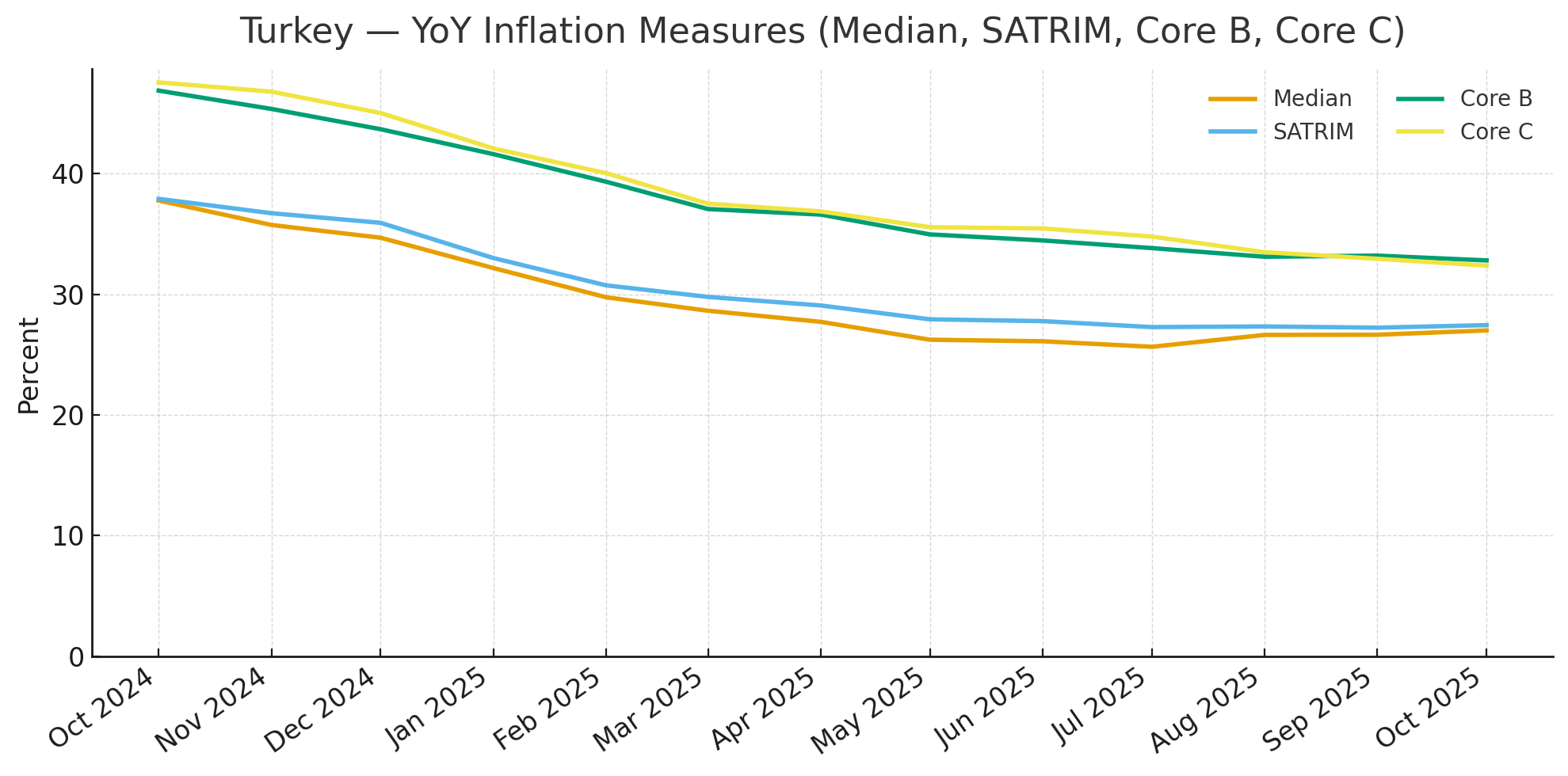
At face value, median and SATRIM readings suggest scope for further accommodation by the CBT, but we are more cautious. For this purpose, we conducted a rolling window examination, which revealed median inflation commands superior predictive accuracy for 12-month forward headline CPI across both adjusted and raw specifications, with SATRIM, Core B, and Core C following respectively. Here, we do not get into the technical details, but the results are available upon request. Nevertheless, we observed that forecast error differentials were marginal, precluding definitive conclusions on the superiority of any of the four inflation measures. Extending the analytical horizon to 60 months, to detect potential regime transitions, exposes intervals where median inflation exhibits relative underperformance. This finding, in our assessment, underline that despite median and SATRIM measures' statistical efficiency, exclusive reliance risks policy misalignment. Specifically, we would consider it excessive confidence on the part of the CBT if it justifies its accommodation purely because median and SATRIM register sub-30% readings, while disregarding Core B and Core C dynamics.
Amid mounting concerns, the CBT's Q4 inflation report maintained a 24% target, while the upper bound of the projection range was revised higher yet again to 33%. This marked the third upward revision to the upper band since Q4/2024, when the 2025 year-end inflation forecast stood at 21%, we remind. In other words, the CBT has revised its 2025 forecast higher by a cumulative 12pps within a year, we underline. Such a magnitude and frequency of revisions inevitably cast doubt on the robustness and credibility of the CBT's forecasting framework, prompting market participants to question the reliability of forward guidance, we assess.
Notwithstanding these concerns, we reiterate our existing CBW stance and emphasise that any further rate cuts should be put on hold in order to safeguard the disinflation process and anchor expectations more firmly for the upcoming year.
Summary of October rate-setting meeting
| Ask the editor | Back to contents |
| BCCh's cautious guidance hints next cut waits for 2026, decision tree simplified |
- Next MPC meeting: Dec 16, 2025
- Current policy rate: 4.75%
- EmergingMarketWatch forecast: Hold
The BCCh's monetary policy council held its benchmark interest rate unchanged at 4.75% in its Oct 28 sitting, as was widely expected, and maintained a cautious tone in its brief guidance that suggests the next cut is likely to wait for 2026. While the guidance was deliberately vague about the triggers and timing for a future cut, we would argue that the monetary policy decision tree currently looks simple. We have been forecasting no more cuts in 2025 since the BCCh published its last monetary policy report, but consensus polls ahead of the October sitting showed a majority still forecasting a 25bps cut in December. That scenario remains plausible, the consensus is likely to shift toward a hold in December and a cut in January with the new BCCh guidance. We are leaning toward March for the next cut.
The monetary policy story looks fairly simple right now. CPI inflation has been above the 3.0% y/y monetary policy target since the pandemic. After hitting a post-pandemic low at 3.2% in Q1 2024, inflation increased and has been stubbornly hovering at 4.0%-4.9% y/y since. The monetary policy rate kept declining through 2024 though, pushing the real interest rate down to neutral. With headline CPI inflation currently at 4.40%, expected to end the year above target at 4.00%, and the nominal policy rate at 4.75%, a cut would be hard to justify. In short, the next rate cut will not come until headline and core CPI inflation get closer to 3.0%, and the question is how close would they need to get.
For more context to the monetary policy story, headline CPI inflation still contains some residual effects of an overdue power price adjustment that took place in 2024-2025 after price freeze of five years. Core inflation, which excludes the power price noise, behaved a little better than headline CPI, but still hovered consistently in a 3.5%-4.0% range.
The real side of the economy is largely neutral for monetary policy currently. The central bank estimates that the economy's output gap is very close to zero, and that the GDP growth composition is relatively balanced, with no particular source of inflationary pressure. There are some concerning spots, for example in persistently weak job creation, but this is something the central bank attributed to a combination of recent reforms that significantly raised labor costs. Lending activity has been weak as well, but starting to trend in the right direction in the last couple of months.
Besides the timing for the next cut, the other big question centers on the terminal rate for this cut cycle. The BCCh estimates that the neutral real interest rate is in the 0.50%-1.50% range, and the point estimate is 1.00%. In nominal terms, since the inflation target is 3.00%, the neutral range would be 3.50%-4.50%, but the BCCh would normally be expected to get to 4.00% in the theoretical case that inflation stays at 3.00%. However, recent attempts to replicate the BCCh's methodology for estimating the neutral range yielded that the range should rise to 0.75%-1.75%, and this is leading many to believe that the rate cut process could eventually end at 4.25% or 4.50%. The BCCh has yet to issue any comment on this discussion.
| Ask the editor | Back to contents |
| Inflation expectations rise again in Nov, lifting odds of a BanRep Dec hike |
- Next policy meeting: Dec 19
- Current policy stance: 9.25%
- Last decision: Oct 31 (Hold)
- Our forecast: Hold or hike by 25bps
- Rationale:Rising inflation expectations and uncertainty over the government's minimum-wage decision favor a BanRep rate hike, although large revisions to recent GDP figures mean the Q3 rebound should be taken with caution, keeping a pause on the table.
Inflation expectations among banks and brokerage economists rise again in November, with year-end inflation now forecast at 5.3%, up from 5.2% in October, according to BanRep's latest economic analysts survey. This marks the fourth consecutive monthly increase and indicates a continued decline in the short-term outlook. Expectations for the next twelve months rose to 4.47% from 4.35%, extending a five-month streak of increases. For the twenty-four-month horizon, forecasts increased to 3.8% from 3.7% in October, the third straight rise. Overall, these figures suggest that inflation would only drop below the 4% upper limit of the tolerance band sometime between Nov 2026 and Nov 2027. The survey also includes a sixty-month horizon, which had converged to the 3% target in October but now stands at 3.3%.
Note that this steady upward trend in expectations increases the likelihood that the more hawkish members of the board will support a rate hike at the final meeting of the year on Dec 19. Board member Mauricio Villamizar first brought up this possibility in late October, and Governor Villar echoed it on Nov 12. We believe the most likely outcome remains a 25bp increase, especially if the November CPI report, due on Dec 5, shows renewed acceleration and if the government announces a 2026 minimum-wage adjustment that the central bank would consider inflationary before the meeting. That said, a pause cannot be ruled out. While Q3 GDP surprised to the upside, this does not necessarily argue for keeping rates on hold. From an orthodox inflation-targeting perspective, stronger-than-expected activity would normally support a more restrictive stance, especially if inflation is proving sticky. However, the key issue here is the unusually high uncertainty surrounding the national accounts data. Preliminary GDP figures have been repeatedly and significantly revised in recent quarters: The q/q growth rate for Q1, for example, moved from 0.8% (initial) to 0.3% three months ago, and, most recently, to 0.5% in the Q3 release (when looking at the SA CA adjusted series). Given this pattern, the Q3 rebound should be treated with caution, and BanRep may prefer to wait for more reliable information before tightening policy further.
We therefore believe BanRep is most likely waiting for clarity from the government on the minimum-wage decision. If that announcement is made after Dec 19, and if inflation continues to rise, a rate increase at the end of January 2026 would be hard to avoid.
| Likely stance of BanRep's board members | ||||||||||||||||||||||||||||||||||||||||||||||||
| ||||||||||||||||||||||||||||||||||||||||||||||||
| Source: EmergingMarketWatch |
| Ask the editor | Link to source | Back to contents |
| MPC will likely pause monetary easing in early January |
- Current policy rate: 4.25%
- Next monetary policy meeting: Jan 5, 2026
- Expected decision: Hold
The MPC expectedly cut the policy rate by 25bps to 4.25% on Nov 24 but governor Yaron warned that uncertainties are still there and that the MPC will remain prudent in its decisions. He also said that the latest research division assumption for a policy rate of 3.75% in September 2026 is "definitely reasonable" and even if a revision is forthcoming, he did not expect any changes. Yaron said that the interest rate path must be gradual and should depend on demand not changing faster than the BoI think, supply constraints being reduced, and the fighting not being at high intensity. The latter means two rate cuts by September 2026, which will very much depend on inflation developments and will very likely be roughly evenly distributed in that period, we think. Thus, we expect the MPC to take an on-hold decision in its next meeting in early January sitting on the fence to see how the local economy reacts to the ceasefire and the start in the monetary easing.
Inflation stabilised m/m at 2.5% y/y in October and was within the 1-3% target range for the third month running. It was just in line with expectations in October but surprised positively in the previous two months. The latest inflation expectations, one of the major considerations the MPC is looking at when deciding on the policy rate, pointed to continued moderation in the inflation environment and the latest forecasters' inflation expectations for the next one year fell to a low not seen since Jan 2022. The BoI said it expected inflation to increase by the end of the year and then start easing towards the middle point of the 1-3% target range. However, Adi Brender, a MPC member and the chief of the research department at the Bank of Israel, said that despite the expected fluctuations, inflation is to remain within the target range in the coming months. He also stated that there are factors that make it difficult inflation to decelerate further like the demands of the army to maintain a large number of reservists, which is affecting the labour market, and the still lower number of flights to/from the country compared to the period before the war. The BoI also said that geopolitical developments and their impact on economic activity, an increase in demand alongside supply constraints, and fiscal developments are risks that can lead to potential inflation acceleration. The governor explicitly noted that if the budget policy is expansionary to the extent that it leads to an increase in demand and acceleration in inflation, the MPC will need to address this issue.
GDP growth rebounded in Q3, at much higher than expected 12.4% in saar terms (seasonally-adjusted annualised rate). The deviations of the GDP and the business product from their long-term trends moderated but apparently have not closed. The BoI assessed economic activity in Q4 as "lively" but not at the level of Q3 and pointed to the improvement in sentiments, the high capital raising, and the continued recovery in foreign trade. However, the labour market remained tight and wages continued to increase. We note that the BoI has flagged the wage growth as one of the concerns regarding inflation developments. Yaron assured though that the current wage growth is not yet pushing inflation higher.
Board statements, press briefings, minutes from MPC meetings
| Ask the editor | Back to contents |
| NBK still expected to keep base rate on hold |
- Current policy rate: 18%
- Next monetary policy meeting: Nov 28
- Expected decision: hold
We still expect the NBK to keep the base rate on hold at the Nov 28 meeting. We remind that the CPI rate posted 12.6% y/y in October, falling from 12.9% y/y in September. This is reinforced by lower monthly price growth and we note that the CPI rate is now closer to the bank's year-end forecast range (11-12.5%). In addition, today NBK governor Suleimenov took part in a government meeting. He spoke to journalists afterwards and indicated the base rate is more likely to remain unchanged, which is why we maintain our baseline scenario for an on-hold decision.
Household inflation expectations registered renewed volatility in October, but this is in line with the bank's general expectations, so we doubt it will be decisive. We also note that the tenge has strengthened against the US dollar in recent weeks, with the NBK praising the attractiveness of KZT assets. For the time being, fuel prices will remain frozen, while the utility tariff reform will only resume in Q2 2026. This means there is scope for inflationary tendencies to ease in the foreseeable future, as long as the authorities manage to curb food inflation.
Overall, we expect the NBK will wait to assess the full effect of October's 150bp hike as current inflation dynamics allow for such a move. The likelihood of further monetary tightening will not dissipate due to the upcoming implementation of the new tax code. An inflationary push is expected and its impact is difficult to ascertain in advance as the reaction of local enterprises will be decisive in the end.
| Ask the editor | Back to contents |
| BOK likely to hold due to hotter inflation, unhinged housing price expectations |
- Next policy meeting: Nov 27
- Current policy stance: 2.50%
- Last decision: Oct 23 (Hold)
- Our forecast: Hold
- Rationale: BOK has consistently signalled concerns about real estate prices
The Bank of Korea is likely to hold its policy rate yet again at 2.5% in its next policy meeting on Nov 27 due to its concerns about excessive real estate speculation, in our view. We remind that the BOK has held its policy rate at 2.50% in the past 3 meetings, with only 1 member voting for a rate cut in the past 2 meetings. The central bank had signalled a wait-and-see attitude regarding the impact of macroprudential measures taken by the government in late June and mid-October to tame real estate prices, especially in the capital Seoul.
Considering that both growth and inflation have picked up recently, BOK is likely to stay on hold for longer, or potentially change its policy stance. The bank has maintained a policy easing stance throughout the entire 2025 in light of the fact that GDP growth remains below the estimated potential growth rate of 2%. However, BOK's governor Rhee signalled a potential shift in the policy stance in an interview on Nov 12, depending on incoming data.
Real estate prices remain key factor preventing easing
In our view, the central bank would have cut the policy rate by 25bps in its previous meeting on Oct 23 if real estate prices did not surge higher at the beginning of the month. As a result, authorities adopted a new round of macroprudential measures on Oct 15 aimed specifically at discouraging real estate speculation in the capital Seoul. The government has been also supportive of BOK's actions, with President Lee supporting the rate freeze in an interview on Oct 27 in which he also said the real estate market is a "ticking time bomb."
At the same time, the BOK released a report on Nov 11 in which the authors said that further monetary policy easing might be ineffective due to the unreasonable housing price expectations that distort investment activity and crowd out other investment. The minutes from the Oct 23 meeting also showed that five out of the six BOK members expressed serious concerns about the situation in the property market as only 1 member voted for a rate cut in last month's meeting.
Looking at recent data, apartment prices in Seoul rose by 0.19% w/w in the week ending Nov 3, which is still a very strong increase as it implies an annualized growth of more than 10%. In our view, the BOK will want to see apartment price growth rate of below 0.10% w/w in the capital Seoul before it resumes easing.
Inflation reaches a 15-month high in October as domestic demand recovers
CPI inflation accelerated to 2.4% y/y in October from 2.1% y/y in September, reaching a 15-month high. This is another reason for the BOK to stay on hold as inflation accelerated tangibly for a second month in a row. In particular, core CPI inflation remained relatively high at 2.5% y/y in October, which suggests some revival in demand-pull pressures. Still, most forecasts continue to expect that inflation will average around 2% in both 2025 and 2026.
Simultaneously, domestic demand rebounded in Q3 as private consumption rose at the fastest pace in 12 quarters by 1.3% q/q in Q3 led by the consumption stimulus provided by the new government. In addition, the construction downturn seems to have bottomed in Q3, which supported the recovery of investment demand. As a result, gross fixed capital formation rose by 0.8% q/q in Q3 and posted its first increase in 9 quarters. Despite the impact of US tariffs, net exports also gave a positive contribution of 0.1pps to growth in Q3 thanks to high-flying sales of memory semiconductors.
Conclusion
Overall, the BOK is less pressured to cut rates due to the strong performance of the domestic economy in Q3, the surging memory semiconductor exports, and the diminished uncertainty about US tariffs. In addition, the new government has given clear signals that it is looking to support growth with a pro-growth Budget 2026. On the other hand, both inflation and real estate prices have become hotter. The persistent weakening of the Korean won versus the US Dollar is another factor that will likely impact BOK's policy decision.
In our view, a rate hold in November is almost a done deal as the central bank awaits both a normalization of the property market and the new economic forecasts that will be released in November. Looking at 2026, the BOK might adopt a neutral stance depending on its expectations for growth next year. In particular, if the growth forecast is revised closer to the potential growth rate of 2% in 2026, the BOK will have few reasons to maintain the current easing stance.
Useful Links
| Ask the editor | Back to contents |
| BNM to stand pat in near term on improved growth outlook, modest inflation |
- Next policy meeting: 22 January, 2026
- Current policy rate: 2.75%
- Our forecast: Hold
- Last decision: Hold (November 6, 2025)
- Rationale: Impact of US' tariffs has so far been muted while domestic demand remains resilient. Benign inflation and strengthening ringgit to provide further room to maintain the key rate
Bank Negara Malaysia left the overnight policy rate (OPR) unchanged at 2.75%, marking the second consecutive meeting with no change in the key rate. The decision was in line with market expectations as none of the economists surveyed by Bloomberg and Reuters predicted any policy change. BNM maintained its balanced stance, noting that the current OPR level is appropriate and supportive of the economy amid price stability.
With growth proving more resilient than previously anticipated, inflationary pressures broadly contained, and the ringgit strengthening, we expect BNM to keep the benchmark interest rate steady in the near term - at least through mid-2026. The policy rate was last adjusted in July, with a 25bps cut, prompted by potential adverse impact of US tariffs, which also led the central bank to lower its 2025 GDP growth forecast to 4.0%-4.8%, from 4.5%-5.5%.
GDP growth
GDP growth likely accelerated to 5.2% y/y in Q3 2025, up from 4.4% y/y in the previous quarter, according to DOSM's advance estimate. The final print due on Nov. 14 is expected to confirm the 5.2% expansion. The stronger-than-expected growth was underpinned by a solid recovery in mining output and continued strength across the manufacturing, construction and services sectors. This suggests that impact of the US tariffs has so far been muted, with exports surging 12.2% y/y in September. Shipments to the US jumped 24.4% y/y, led by record high exports of electrical and electronics (E&E).
BNM said resilient domestic demand, supported by a firm labour market and robust investment activity, will continue to support growth into 2026. However, it warned of downside risks from slower global trade, weaker sentiment, as well as lower-than-expected commodity production. The Trump administration's proposed up to 300% tariff on semiconductor imports poses key threat, considering the US is Malaysia's third-largest market for chips.
For now, exports are expected to maintain their strong momentum, aided by a global technology upcycle, the easing of US-China trade tensions, and Malaysia's trade deal with the US, which exempts about 12% of its exports (worth about USD 5.2bn) from American tariffs.
On Tuesday, PM Anwar Ibrahim said that told the parliament that full-year GDP growth could surpass the government's 4% to 4.8% forecast. During Jan-Sep, GDP rose 4.7%. For 2026, the government projects growth between 4.0% and 4.5%.
Inflation environment
CPI inflation rose to a seven-month high of 1.5% y/y in September from 1.3% y/y in August, while core inflation quickened to 2.1% y/y - the fastest pace in nearly two years - in part driven by the recent expansion of the sales and services tax to new categories. Nonetheless, price pressures have been largely kept in check, with the headline figure averaging 1.4% in the first nine months of 2025, down from 1.8% in the same period last year. Inflation is likely to clock in at the lower end of BNM's 1.5%-2.3% projection for this year. The forecast is higher than the Finance Ministry's forecast range of 1%-2.0%.
BNM maintained its favourable inflation forecast for 2026, expecting both CPI and core inflation to remain moderate. It noted that subdued global commodity prices are likely to keep domestic cost pressures contained. Core inflation was seen remaining close to its long-term average, reflecting continued expansion in economic activity and the absence of excessive demand pressures. The central bank reiterated that domestic policy reforms - including subsidy rationalization and sales and services tax expansion - are expected to have limited impact on inflation.
Exchange rate
BNM did not comment on the ringgit's performance, suggesting it was not a big factor in its decision-making. The central bank is likely taking comfort from the strengthening of ringgit, which has appreciated by 7.7% against the US dollar so far this year, making it Asia's top performer this year. The USD/MYR fell to 4.1320 as of Nov. 12 - the lowest since September 2024. The government sees the exchange rate to fall below the 4.0 level over the next year on the back of sound domestic fundamentals. The pair last traded below the 4.0 level in June 2018.
Conclusion
Overall, improved growth prospects, benign inflation and a strengthening ringgit prompted BNM to hold the OPR at 2.75%. BNM is likely to be content with its July 25bps cut, given that the economy has so far defied US' tariffs. We expect the key rate to remain unchanged in the near term.
Further Readings
| Ask the editor | Back to contents |
| NBR very likely to hold policy rate at 6.5% at least by end-Q1 2026 |
- Next MPC meeting: Jan 19, 2026
- Current policy rate: 6.50%
- EmergingMarketWatch forecast: Hold
Rationale: Romania's central bank will very likely maintain the key policy rate at 6.50% in the first MPC meeting in 2026, on Jan 19, and will very probably make no changes in Q1 2026. Even though inflation picked up below expectations, to 9.88% in September and eased slightly more than expected to 9.76% in October, its subsequent moderation trend is seen very slow in the following three quarters and on a higher path than previously estimated.
The central bank sees a more pronounced decline in inflation starting in H2 2026, supported by statistical base effects, which in turn increases the probability of rate cuts, in our view. Therefore, we believe that the prudent approach would be to hold on the key rate steady until disinflation becomes certain, particularly since the expiration of the natural gas price cap expires in March.
The fiscal consolidation measures are going to have a containing effect on private consumption and inflation will start falling gradually already at the start of 2026 and more visibly as of Q3 2026 after the higher base enters calculations, according to the NBR. Thus, inflation will enter the target interval (2.5%+/-1pp) at the end of 2026 and will continue slowing down to 2.7% y/y in Q2 2027 as the fiscal consolidation measures are to assist in stabilising the country's economy.
The high inflation is not expected to result in a rate hike either, as Governor Mugur Isarescu previously assured, adding that monetary policy was partly aimed at avoiding recession risks. He also said that there were risks for a recession mainly due to external factors because of the export-dependency of the industrial sector, to which massive reduction in consumption is to contribute too. Acceleration of the EU funds absorption might offset those and the country might avoid a recession, however, the governor added. Isarescu said that economic growth might linger in the 0-1% range in the next year, according to his estimates.
| Ask the editor | Back to contents |
| CBR likely to keep key rate at 17%; moderate cut remains an option |
- Сurrent policy rate: 17.0%
- Next monetary policy committee meeting: Oct 24
- Expected decision: hold
Forecasting the next CBR rate decision is more difficult than usual, seen also in the market consensus which is split almost equally between a hold and a 100bp rate cut. On one hand, arguments for keeping the rate unchanged are an increase in core inflation, distorted by one-off factors, as well as a sharp rise in inflation expectations of companies and professional forecasters. On the other hand, arguments for a cut include too moderate credit activity, weakening in demand, and a rather neutral fiscal stimulus for now. This is taking place amid an uneven external environment, which may require additional measures to support economic activity. However, given that the CBR has often acted more hawkishly than even the market's most cautious forecasts, we expect it to keep the key rate at 17.0% or cut by a below-consensus 50bps.
Inflation reached 8.5% y/y as of Oct 13, gradually increasing since September. SAAR inflation also picked up to 6.7% in September, way above the 4% inflation target again. Thus, the average SAAR came in at 6.4% in Q3, compared to 4.8% in Q2. However, we note that Q3 inflation is still significantly lower than CBR's expectations (8.5%), but in Q4 it should be higher as the CBR expected it closer to 4%. The indexation of utility tariffs certainly contributed to this acceleration, but was not the main factor this year. Since the beginning of September, we have observed an earlier-than-usual rise in fruit and vegetable prices and accelerating fuel price growth. Moreover, the increased inflation rate for meat products and drugs also contributed to the overall negative result. Growing prices are explained by lack of supply rather than high demand. Following the rising inflation, as well as very early price adjustments ahead of the VAT increase taking effect in early 2026, inflation expectations in October accelerated and reached 19.6% among companies - the highest level since March. Analysts surveyed by the CBR also raised their expectations for both the current year and 2026. Household inflation expectations for October are yet to be published, while the improved data for September are likely outdated.
Bank lending rates in September still suggest overcooling as growth in lending to households dropped further to 2.8% y/y due to muted demand, while lending to companies eased to 9.5% y/y amid lower output. Both sectors continue to borrow more modestly also in monthly terms with the smallest decrease observed in mortgages, which rely on subsidies. The same is true for savings in both y/y and m/m perspective. Back in September, it was expected that a small cut would make the market anticipate a longer hawkish stance and decrease demand for credit. In our view, that is happening now. Such low credit activity suggests a policy rate cut, but as the CBR is long concerned with demand that is too high for supply to keep up with, we doubt that it can be the main argument.
Regarding the new 2026 budget, the CBR clearly wants to present it as a disinflationary factor that does not force it to take a more hawkish monetary stance. CBR officials commented that the budget law does not over-expand expenditures and moves towards increasing indirect taxes, instead of an even bigger deficit, which is welcome. They also emphasized that this would lead to only a slight adjustment to the macro forecast. In our view, despite the legitimacy of all these arguments, the regulator may still fear an increase in the deficit by the end of this year and early next year due to advance payments based on the pattern of the last two years. Doubts may also lie in the area of revenue collection.
| Ask the editor | Back to contents |
| MPC set to signal confidence in disinflation path and opt for cut in November |
Next MPC announcement: 20 November 2025
Current policy rate: 7.0%
EmergingMarketWatch forecast: 6.75%
We expect the MPC to deliver a 25bps rate cut in November, lowering the repo rate to 6.75%, stepping on the now formally adopted lower 3.0% inflation target with a 1% tolerance band, and looking through the temporary upside pressures on CPI in the final quarter while as usual focusing on the policy horizon. The structural shift in the inflation-targeting framework is expected to embed lower inflation into wage negotiations, social grants, and administered-price adjustments. This shift materially alters the longer-term outlook for services inflation, including education, medical insurance, and utilities, which have historically contributed to higher inflation persistence.
The October CPI print will be available for the MPC meeting in November where we expect an acceleration to 3.6% y/y from 3.4% y/y recorded in September. The SARB's Q4 forecast of 4.0% may be revised lower, potentially towards 3.8-3.9% amid the currency's appreciation and declining global oil prices. Domestic fuel price data from the CEF already point to a moderate pump price cut in December, while rand firmness, if sustained, supports further moderation into 2026. In this context, the MPC's emphasis on the policy horizon rather than temporary base effects reinforces the argument for measured easing.
Governor Lesetja Kganyago has reiterated that the central bank's priority is to entrench disinflation and drive expectations closer to the new target. He has highlighted that business inflation expectations remain "sticky," even as trade-union expectations have moderated, stressing that the SARB will "bring them down" through credible policy. He has also drawn a direct link between the lower inflation target and South Africa's sovereign risk premium, underscoring that a credible disinflation trajectory reduces borrowing costs and strengthens the macro-financial foundation.
This credibility has recently received additional support from South Africa's exit from the FATF grey list, which removes a persistent drag on risk assessments and financial-sector confidence. Furthermore, recent discussions around a potential S&P credit rating upgrade provide an even more favourable backdrop. Together, these developments reinforce the downward drift in the sovereign risk premium and improve the transmission of monetary policy through lower funding costs and better capital-flow dynamics.
The global environment also provides cover for easing after the recent 25bps Fed cut widened the SARB's room to manoeuvre and a November reduction would preserve the interest-rate differential even if the Fed remains cautious in December. The rand continues to benefit from softer global dollar dynamics, though geopolitical tensions and trade-related protectionism still weigh on broader emerging-market sentiment. The SARB has consistently noted that monetary policy alone cannot offset structural impediments, but the combination of credible fiscal coordination, governance improvements, and reduced sovereign-risk pressure has materially strengthened South Africa's macro footing.
Overall, we expect a majority of MPC members to favour a 25bps reduction, particularly given that two members already voted for a cut at the September meeting. The balance of evidence since then including lower inflation risk, improved credibility, a stronger institutional backdrop, and supportive global conditions could sway the MPC majority toward another cut after the pause in September.
Provided inflation expectations continue to move toward the 3% anchor and CPI follows the projected disinflation path, the SARB should have room for further gradual reductions in 2026, aligning the policy stance with inflation settling at 3% over the forecast horizon.
Monetary Policy Committee Statement
| Ask the editor | Back to contents |
| CBSL to hold rates in near term |
- Next Policy Meeting: TBC
- Overnight Policy Rate (OPR): 7.75%
- Previous Decision: Hold (Nov 26)
- Our Forecast: Hold
- Rationale: Growth is broadening, inflation has turned positive, and IMF momentum remains intact, but subdued reserves and fragile external conditions warrant caution.
The Central Bank of Sri Lanka (CBSL) maintained the policy rate at 7.75% for a third consecutive meeting on Nov 26, opting to keep its monetary stance neutral as the effects of earlier easing continue to filter through the economy. Having cut rates by 250 basis points between March and May 2025, the CBSL has since pivoted to a watchful pause, balancing a firming growth outlook and low but rising inflation against weak reserve accretion and a modestly depreciating currency.
The policy hold comes as key macro anchors remain steady. The IMF Executive Board is expected to approve Sri Lanka's fifth review under the USD 3bn Extended Fund Facility (EFF) on December 15, triggering a disbursement of USD 347mn. The staff-level agreement, finalised in October, affirmed Sri Lanka's reform traction and upward growth surprise. The IMF flagged continued fiscal discipline and a cautiously improving external position, but also noted the importance of protecting the vulnerable and accelerating structural reforms, including trade liberalisation and governance.
Inflation Outlook
Inflation has returned to positive territory after nearly a year of deflation. Colombo CPI rose 2.1% y/y in October, up from 1.5% in September, led by food inflation, which climbed to 3.5% y/y, while non-food prices also picked up to 1.4% y/y. Contribution to overall inflation came nearly equally from food (1.12%) and non-food (0.95%) categories, suggesting that the price gains are becoming more broad-based.
The CBSL expects inflation to gradually converge with its 5% medium-term target by mid-2026, supported by recovering demand and normalising costs. Core inflation stood at 1.5% y/y in October. While price pressures remain contained, weak wage growth and soft credit expansion continue to weigh on aggregate demand. As a result, the CBSL has opted to maintain a neutral bias, preferring to let past rate cuts transmit fully before recalibrating.
Growth Momentum
Growth indicators have turned broadly positive, supported by festive season demand, investment momentum, and improved credit conditions. Industrial production rose 6.2% y/y in Q3, marking the third straight quarter of post-crisis recovery. That said, momentum eased slightly in September (4.7% y/y), down from 7.6% in August, as refined petroleum output and machinery production dipped due to base effects and inventory adjustments.
The Manufacturing PMI surged to 61.0 in October, signalling strong expansion. New orders, especially in food and beverages, drove the rally, while production, employment, and stockpiling also picked up. Sentiment for the next quarter is optimistic, underpinned by year-end demand and improved business confidence. The Services PMI also rose sharply to 66.0, from 58.7 in September, driven by wholesale and retail trade, financial services, and personal services. New business orders, especially in finance, continued to grow, and hiring remained positive, albeit more modest. The strong PMI readings point to a broad-based Q4 rebound, reinforcing the view of a domestic consumption-led recovery.
External Conditions
Sri Lanka's external position softened in September, recording the first monthly current account deficit of 2025 at USD 183mn, largely due to a 43.7% y/y surge in the trade deficit. Imports jumped 24.5% y/y-driven by vehicle and capital goods-while exports rose 12.5% y/y. Despite the monthly setback, the Jan-Sep current account remained in surplus at USD 1.9bn.
The services account delivered cumulative net inflows of USD 2.9bn, bolstered by tourism earnings (USD 2.5bn, +5.3% y/y) and transport services. However, monthly inflows dipped due to weaker maritime and air transport. Worker remittances remained a key buffer, rising 25.2% y/y in September to USD 696mn, the highest monthly figure since 2020. Gross official reserves held steady at USD 6.2bn, with the rupee depreciating 3.9% YTD by end-October.
Outlook
The CBSL's monetary policy remains calibrated to protect macro stability while enabling recovery. With inflation stabilising, industrial output broadening, and the PMI showing renewed business confidence, the economic rebound appears to be gaining structure. However, slower reserve accumulation, a widening trade gap, and uncertain global financial conditions argue for a prudent stance.
The 2026 Budget, yet to be passed , targets a 5.1% fiscal deficit and commits to maintaining the IMF reform trajectory. With no major tax hikes, a focus on digitalisation, targeted social spending, and renewed investor facilitation measures, the budget supports CBSL's efforts to anchor expectations without overheating the economy. For now, policy settings are likely to remain unchanged through Q1 2026. A rate cut may materialise only if inflation remains durably below 3%, reserves show sequential gains, and fiscal consolidation continues to hold. The central bank's next move will hinge on a delicate mix of domestic recovery signals, external account resilience, and global monetary dynamics.
| Ask the editor | Back to contents |
| Hold decision, 25bp rate cut both possible on Dec 17 |
- Next MPC meeting: Dec 17
- Current policy rate: 1.50%
- EmergingMarketWatch forecast: Hold or 25bp cut
- Rationale: GDP for Q3; CPI for October; continuing baht strength
A hold decision and a 25bp policy rate cut both seem possible at the next meeting of BOT's Monetary Policy Committee (MPC) on Dec 17, the last one for 2025, in our view. In October, the MPC voted 5 to 2 to keep the policy interest rate unchanged at 1.50%. Two MPC members favoured a 25bp cut. This was the first MPC meeting under Governor Vitai Ratanakorn. There had been four policy rate cuts totalling 100bps since Oct 2024.
Some of the new data support the expectation of a 25bp cut. These include a lower-than-expected GDP growth in Q3, as well as persistently negative CPI inflation and strong baht. On the other hand, the household debt is still high - it was equal to 86.8% of GDP in Q2. The need to preserve policy space remains another argument in favour of a hold decision.
Economic growth
The GDP increased by 1.2% y/y in Q3, decelerating from a revised 2.8% y/y growth in Q2, the office of the national economic and social development council (NESDC) said on Monday. The latest result is below the 1.6% forecast of Reuters and Bloomberg polls. In October, the BOT had predicted economic growth of 1.5% y/y in Q3 and 1.3% y/y in Q4. In seasonally adjusted terms, GDP fell by 0.6% q/q in Q3, reversing a 0.5% q/q increase in Q2. The GDP rose by 2.4% y/y in Jan-Sep. The country's economy expanded by 2.5% in 2024.
The NESDC also announced its economic projections for 2025 and 2026. GDP growth is expected to be 2.0% this year and in the range 1.2-2.2% next year. Investment is forecast to rise by 3.3% in 2025 and 1.4% in 2026. The NESDC expects deceleration of both private investment (to 0.9% from 2.0%) and public investment (to 2.9% from 6.8%). Private consumption growth is predicted at 2.8% this year and 2.1% next year. Government consumption is expected to increase by 0.3% and 1.2% respectively.
The export value of goods is forecast to fall by 0.3% next year, following 11.2% growth this year. At the same time, the agency projects that foreign tourism receipts will rise to THB 1.65tn in 2026 from THB 1.52tn in 2025. All in all, the export volume of goods and services is anticipated to increase by 8.8% this year and 1.1% next year. The respective growth rates of the import volume of goods and services are 5.2% and 0.4%.
Last Thursday, an IMF Article IV mission forecast that Thailand's GDP would rise by 2.1% in 2025 and 1.6% in 2026.
Inflation
The headline CPI fell by 0.76% y/y in October, after dropping by 0.72% y/y in September. The headline inflation has been negative for seven consecutive months. The CPI growth has been below the target range of 1-3% for the eighth month in a row. Consumer prices edged down 0.11% m/m in October. The headline inflation was -0.09% y/y in Jan-Oct. The core CPI rose by 0.61% y/y in October, decelerating from 0.65% y/y in September. The core CPI increased by 0.87% y/y in Jan-Oct.
On Monday, the NESDC forecast CPI inflation of -0.2% this year and in the range 0.0-1.0% next year. Last week, the IMF mission forecast average headline inflation of -0.1% and 0.4%, respectively.
Lending
The banking system's loans fell by 1.0% y/y in Q3, the same rate of contraction as in Q2. This was driven by a continued decline in SME and consumer loans, whereas large business loans increased modestly. Business loans hence fell by 0.6% y/y in Q3, after decreasing by 0.3% y/y in Q2. At end-September, the y/y growth of large business loans and SME business loans was 0.7% and -4.0% respectively. Consumer loans declined by 1.7% y/y at end-September, following a 2.1% y/y contraction at end-June. Business and consumer loans accounted for 62% and 38% of the total, respectively.
The NPLs amounted to THB 544.0bn in Q3, down from previously reported THB 554.9bn in Q2. There was a slowdown in new NPLs. The NPL ratio rose to 2.94% in Q3 from a revised 2.89% in Q2. The BOT noted the shrinking loan base. The NPL ratio for business loans increased to 2.78% in Q3 from 2.71% in Q2. The NPL ratio for consumer loans edged down to 3.28% from 3.29%.
The ratio of Stage 2 loans to total loans rose to 7.24% in Q3 from 6.88% in Q2. For business loans, the ratio increased to 6.95% from 6.41%. For consumer loans, the ratio edged down to 7.87% from 7.90%. The increase in Stage 2 loans was driven by the large corporates segment, as well as improved loan classification from Stage 3 (NPL).
Exchange rate
The exchange rate of the Thai baht is USD/THB 32.413 at the time of writing, which compares with USD/THB 32.564 on Oct 8, the date of the latest MPC meeting. The relatively strong exchange rate of the baht is seen as one of the arguments in favour of a rate cut by the BOT.
Further reading
| Ask the editor | Back to contents |
| Another on-hold decision by central bank is likely on Oct 23 |
- Current rate: 15.5%
- Next rate decision: Oct 23
- Our forecast: on hold
The central bank (NBU) has left the key policy rate at 15.5% four times since last spring. Another on-hold decision is likely also tomorrow, although the NBU may also consider a cut, as last summer it planned easing by end-2025. Policy easing would appear premature now, amid the war escalation when Russia has been threatening to black Ukraine out ahead of winter. Also the IMF reportedly pushes for some hryvnya devaluation, which would slow disinflation, and uncertainty about budget financing increased recently.
The NBU's disinflation forecast for H2 2025 has materialised against the background of relative macroeconomic stability and significant foreign aid inflow, slower real wage growth, a good vegetable harvest which eased the food price growth, and on base effects in the utility sector. Headline CPI inflation fell to 11.9% y/y in September from 13.2% in August, which was lower than anticipated by the NBU. At the same time, core inflation at 11.0% y/y in September, down from 11.4% in August, was in line with NBU expectations.
All MPC members were in favour of an on-hold decision at the Sep 10 key policy rate discussion, just like in April, June and July, according to the minutes published by the NBU on Sep 22. The MPC members agreed that there should be room for starting an easing cycle in Q4 2025. At the same time, they differed on its pace. Most of them agreed that the key rate should be cut to 14.5% by end-2025 and further to 12.5% by end-2026, as outlined by the NBU in the July macroeconomic report. But several MPC members advocated a slower pace, to 13%-14% by end-2026.
| CPI Inflation (% y/y) |
|
| Source: Statistics Committee |
| Ask the editor | Back to contents |


